How Much Does a Sailboat Mast Replacement Cost?
Now I won't ask why you are researching mast replacement - the story behind it is probably tragic and I don't wanna cry as I do whenever I see an injured sailboat. But it is what it is and you simply need a new mast. Let's have a look at how much this will cost, how much of that price is negotiable, and what you need to pay attention to - so that you don't need the services of this article anytime soon.
Replacing a mast costs between $15,000 - $30,000 for an average sailboat. Out of that, $4,000 - $6,000 is the cost of labor. The mast itself costs between $10,000 - $25,000. The total cost of a sailboat mast replacement raises exponentially as you go up in boat size.
But since there are many variables in this, let's have a look at it in more detail to make sure you only pay for what you need.
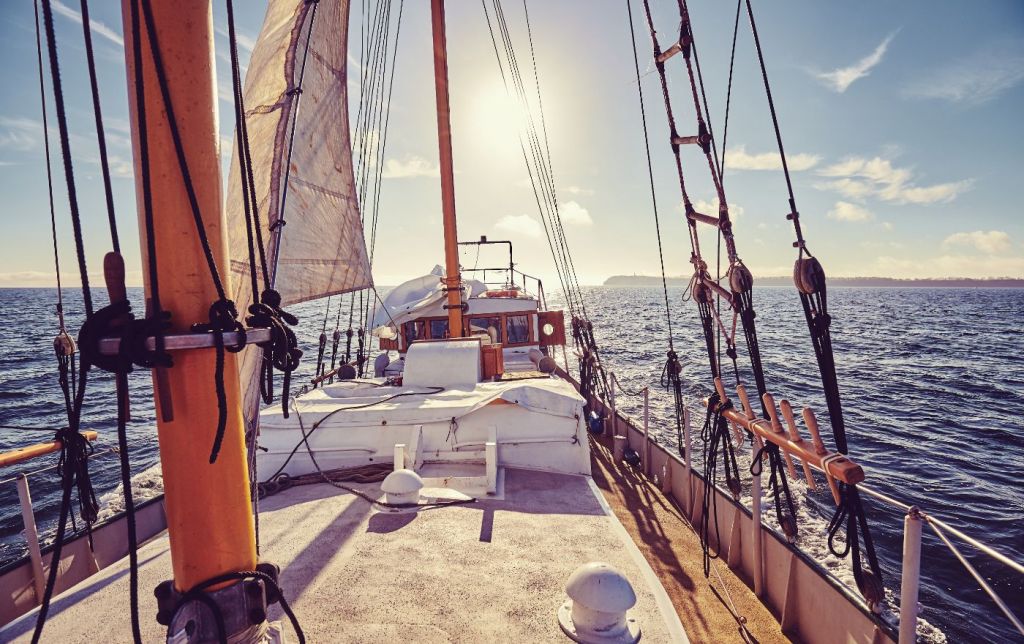

On this page:
Replacing only the mast, replacing the standing rigging, the cost of work (diy to save money), how not to have to replace a mast, in conclusion….
Replacing a mast rarely happens without replacing the standing rigging as a whole - which are the wires that hold the mast in place. So for the sake of simplicity and useability, this will be mentioned in the article. But in case you came here to find out what replacing only the mast will cost, let's have a look. In short, this will cost you around $7,000 - $15,000 for an average-sized sailboat.
But since there are a lot of variables at play here, please take the above figure with a grain of salt - the price is very much dependent on the size and age. As for the size, I am talking about 30-something-footers, and as for the age, I am talking about new masts.
Thus if your boat is bigger, the figure won't apply to you anymore. Similarly, if you just bought an older, $20,000 sailboat and you don't exactly fancy spending half of its price on a new mast, chances are you will pick something used, and then you can find a mast in a reasonable condition for around $2,000.
Buying a second-hand mast is possible, but do make sure it is in a condition worth the money you are paying for it. We will talk about what that condition is later too.
That's it for just the mast, but even if you only came for this figure, don't leave us yet. We will talk about various other costs associated with this operation. After all, it doesn't end with just purchasing the spare parts.
Realistically speaking, chances are that if your mast needs replacement, so does your standing rigging. If the mast is too old, the standing rigging is likely aged too. If the mast got damaged, the standing rigging probably did too. So most of the time, it has to be factored in the cost.
Don't worry though, it is not a significant addition to the overall sum, at least proportionally speaking.
So how much will this set you back? On an average boat with a 30 or so foot length, the standing rigging is likely to cost around $1,500 and upwards. Don't go too far up though, if the quotes you are receiving from riggers in your area go over $2,000, start being suspicious. Not that there is no good reason for the higher price, but do ask questions.
Now, if your boat is bigger than the 30-or-so-footers that we take as the averagely sized boat and you are doing the math in your head now to see what figure applies to you, hold on a second - the price here goes up exponentially, not in a linear fashion. So going up ten feet from the above estimation can easily mean doubling the price, not just adding fifty percent to it.
There is no conspiracy behind this. It is so mostly because the rigging's length goes up, but so does its width. Bigger boats need stronger rigging, and thus your price is growing twice as fast.
As mentioned at the beginning of this article, quite a large chunk of the whole deal is the cost of the work that's gotta be done to put the rigging up. So some might be inclined to do this themselves to save some dollars. Whether this will be worth the time is a question.
Such an endeavor requires a lot of research, not just when it comes to attaching everything that's gotta be attached, but also choosing the right kinds of wires. Not any old wire is up to the job; sailboat rigging has to withstand much more than what the usual manufacturing norm offers.
It will also cost a lot of time, so unless you are prepared to spend it on the repair, don't do it. You might end up hating your boat, and that isn't worth it.
That all being said, if you do want to go at it yourself, you might be saving something over $100 per foot of sailboat length - that is the approximate cost of work required for re-rigging a sailboat. So a 30 something sailboat would set you back some $4,000.
Things don't end here though. There is the cost associated with unstepping the mast, for which you are likely to need a crane. You might want to do this whole thing on dry land, so when calculating, factor in taking the boat out of the water, moving it around, perhaps towing it somewhere, all of which requires time, equipment, and manpower that, if outsourced, might cost around $2,000. And since even if you do this yourself, you will probably have to rent the crane and the trailer, not much is to be saved here.
Replacement of the rigging has to be done every now and then, but to make sure you don't do it more often than necessary, here are a few tips on how to have your boat rigging live as long as possible.
First of all, if you are currently unsure about whether your rigging needs replacing, you can hire a rigger for around $80 to inspect your boat and tell you the state of it. Make sure they are an honest person; it's their job to replace rigging, so telling them yours has a few good years ahead of it still is not exactly in their business interest.
There is a way to check things yourself. Make sure to visually inspect the mast foot, which will be either on the deck or below, if it is connected to the keel. If you see any sign of corrosion, that's bad news. So if you are buying a boat and this is what you find, either don't go for it or expect repairs.
Visual inspection of the rigging works the same way. Visible signs of corrosion are a bad sign, things looking out of order too, luckily consulting the internet can give you a good idea of how what should look even if you are doing this for the first time in your life.
As for the body of the mast, it is okay to have a few scratches on it, but make sure you repair them - the mast is usually coated to protect against corrosion, and scratches tend to go through this coating. The same applies to dings that might have been created because of metal components attached to the lines smacking against the mast. While these won't likely impact the structural integrity of the mast, they can damage the coating. Make sure your lines are in a position where the dings won't happen or that the metal components are wrapped in something to protect the mast.
Speaking of the mast, check whether it is straight. If it bends slightly back, that is considered okay, but any other direction means the rigging isn't holding it in place properly.
And unless this inspection happens after taking the mast down, it is time to go up - hoist yourself all the way up to inspect the mast in its entirety. Check for scratches but also inspect the spreaders. These should be straight and all angled the same way.
Replacing the mast as well as the standing rigging can be a costly endeavor, but one that is a necessary part of a boat owner's life. It will very likely set you back thousands of dollars, but if you take care of your boat well, inspect it regularly and do small maintenance repairs when needed, you will avoid the replacements for as long as possible.
It is also a good idea to pay attention to the rigging when buying a used boat. Because of how much this costs and because much of the rigging tends to be up and thus out of sight, it pays off to have a look at it closely - every now and then some eager sailor buys a second-hand sailboat only to find they have to pay half the cost of the whole vessel for repairs. And that just doesn't make sense.
Jamie Smith
When was this written please? Just need to know when the costs quoted were current.
Leave a comment
Own your first boat within a year on any budget.
A sailboat doesn't have to be expensive if you know what you're doing. If you want to learn how to make your sailing dream reality within a year, leave your email and I'll send you free updates . I don't like spam - I will only send helpful content.
Ready to Own Your First Boat?
Just tell us the best email address to send your tips to:
- Types of Sailboats
- Parts of a Sailboat
- Cruising Boats
- Small Sailboats
- Design Basics
- Sailboats under 30'
- Sailboats 30'-35
- Sailboats 35'-40'
- Sailboats 40'-45'
- Sailboats 45'-50'
- Sailboats 50'-55'
- Sailboats over 55'
- Masts & Spars
- Knots, Bends & Hitches
- The 12v Energy Equation
- Electronics & Instrumentation
- Build Your Own Boat
- Buying a Used Boat
- Choosing Accessories
- Living on a Boat
- Cruising Offshore
- Sailing in the Caribbean
- Anchoring Skills
- Sailing Authors & Their Writings
- Mary's Journal
- Nautical Terms
- Cruising Sailboats for Sale
- List your Boat for Sale Here!
- Used Sailing Equipment for Sale
- Sell Your Unwanted Gear
- Sailing eBooks: Download them here!
- Your Sailboats
- Your Sailing Stories
- Your Fishing Stories
- Advertising
- What's New?
- Chartering a Sailboat
- Cruising Yachts 30' to 35'
Popular Cruising Yachts from 30 to 35 Feet Long Overall Their Physical Properties & Key Performance Indicators
Welcome to this ever-growing gallery of some of the most popular cruising yachts between 30 and 35 feet (9.1m to 10.7m) long overall.
30'-35' Cruising Yachts featured on this page...
Medium sized cruising yachts like these are capable of serious offshore passage making, whilst being reasonably economic to maintain and operate.
And for competitive types, 30-35 foot cruising yachts are a popular size for club racing under handicap rating rules.
Behind each of the cruising yacht images there's a lot more information, including:
- Dimensions & Specifications;
- Design Ratios;
- A summary analysis of the boat's predicted sailing characteristics in terms of performance, stiffness, heaviness, comfort in a seaway and resistance to capsize.
To see it all, just click on the relevant image...
Beneteau Oceanis Clipper 311
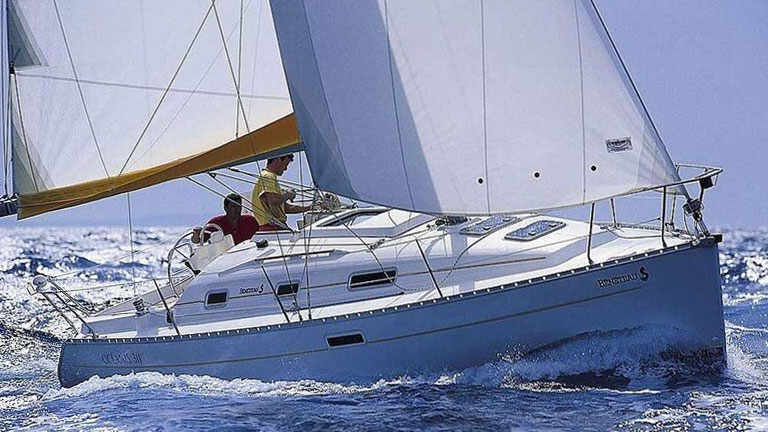
Pearson 303
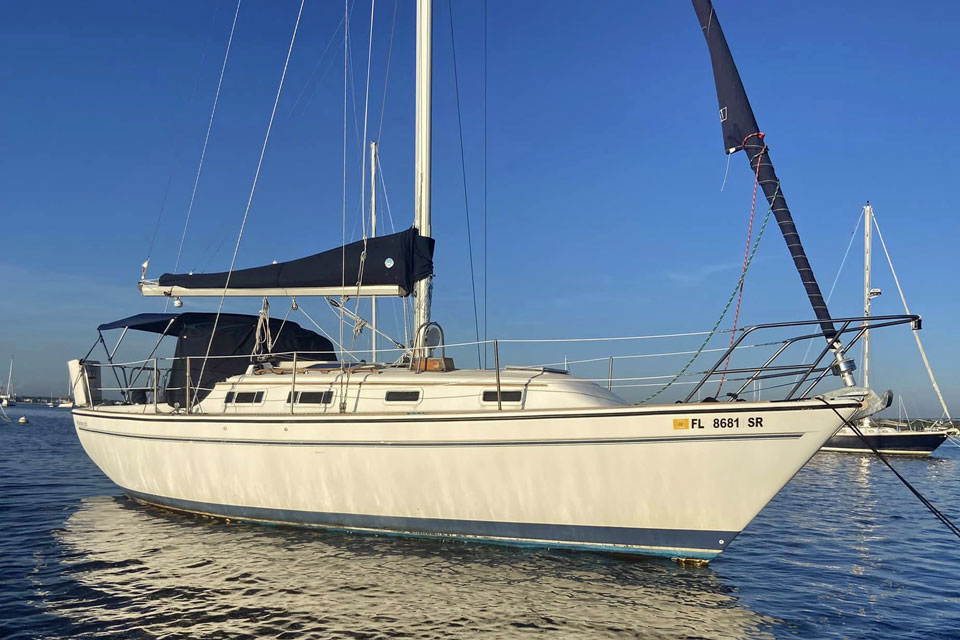
Pearson 323
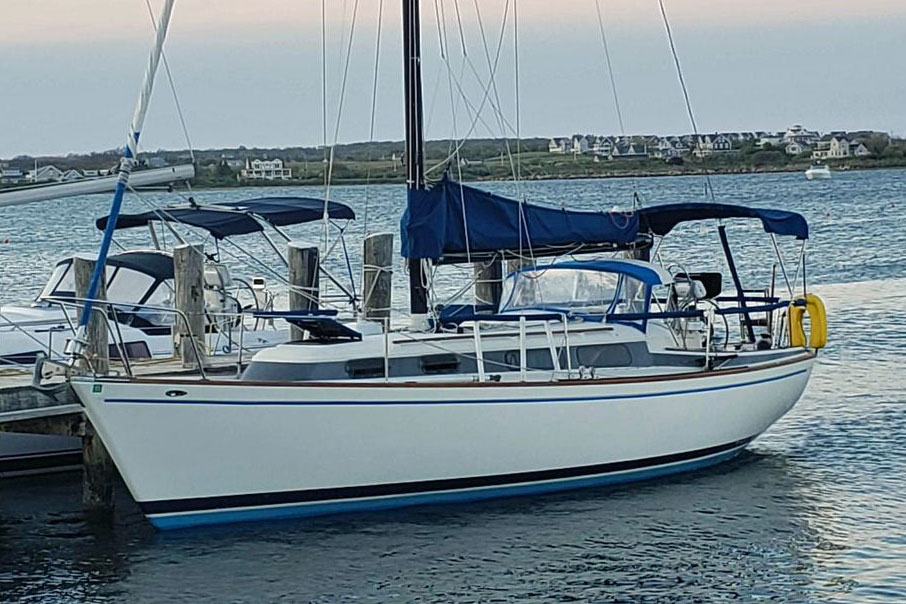
Allied Seawind MkII Cutter
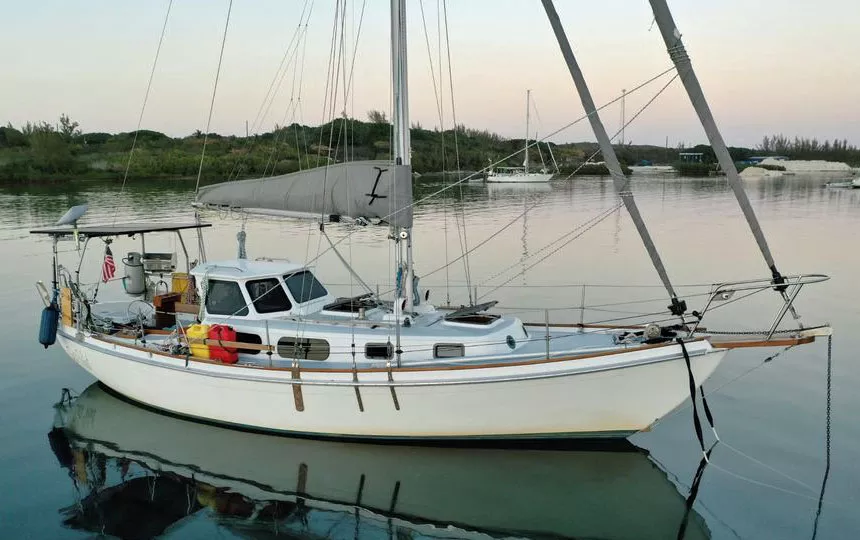
Jeanneau Sun Light 30
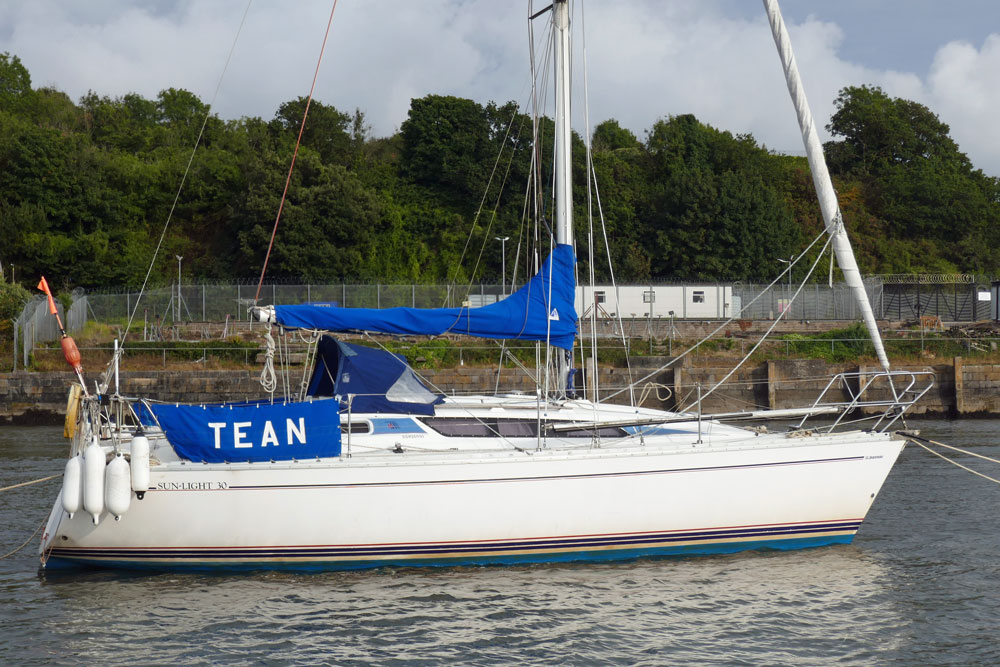
Grand Soleil 343
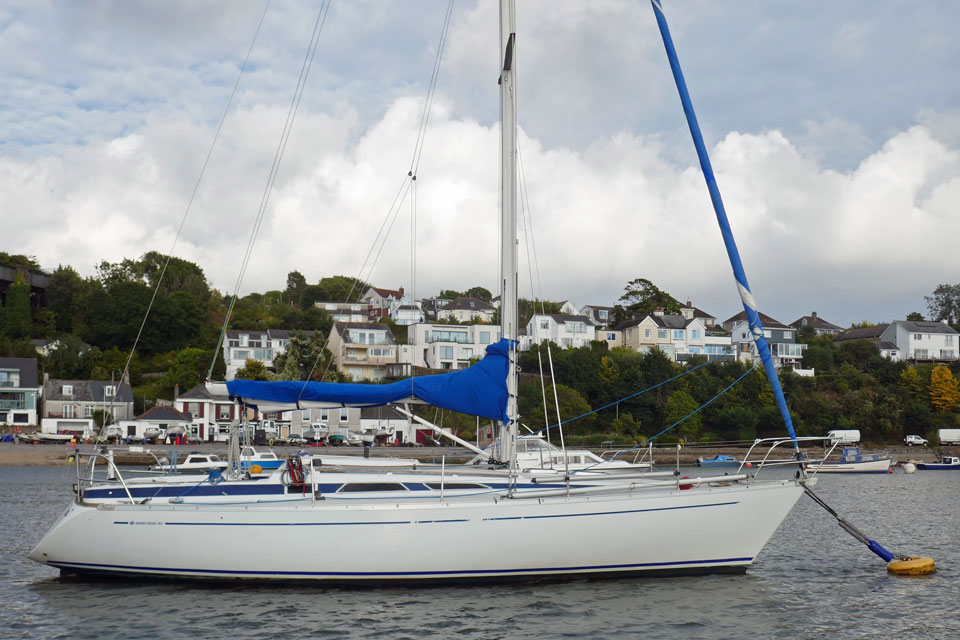
Feeling 850
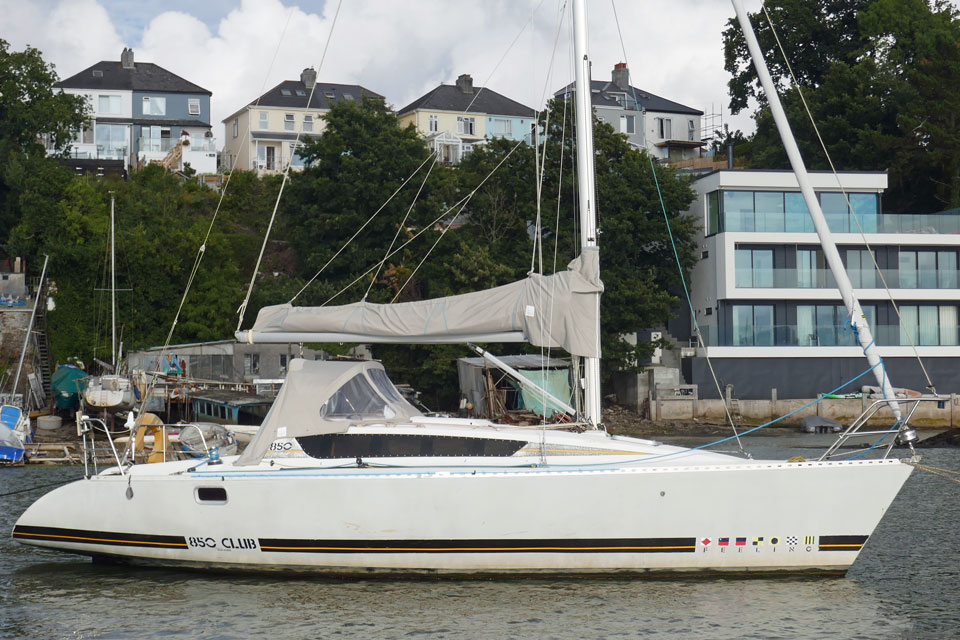
Westerly Tempest 31
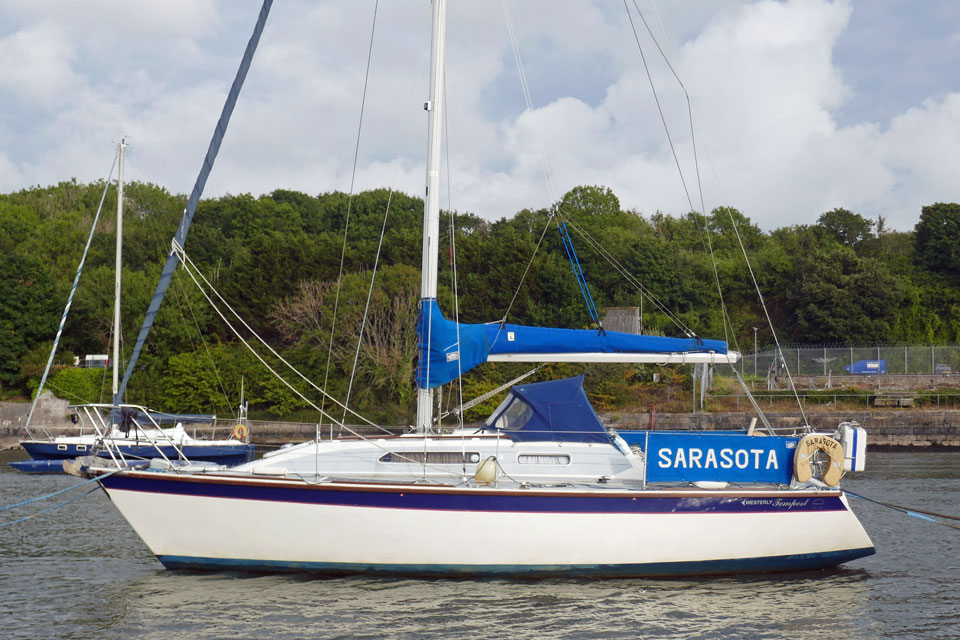
Bavaria 31 Cruiser
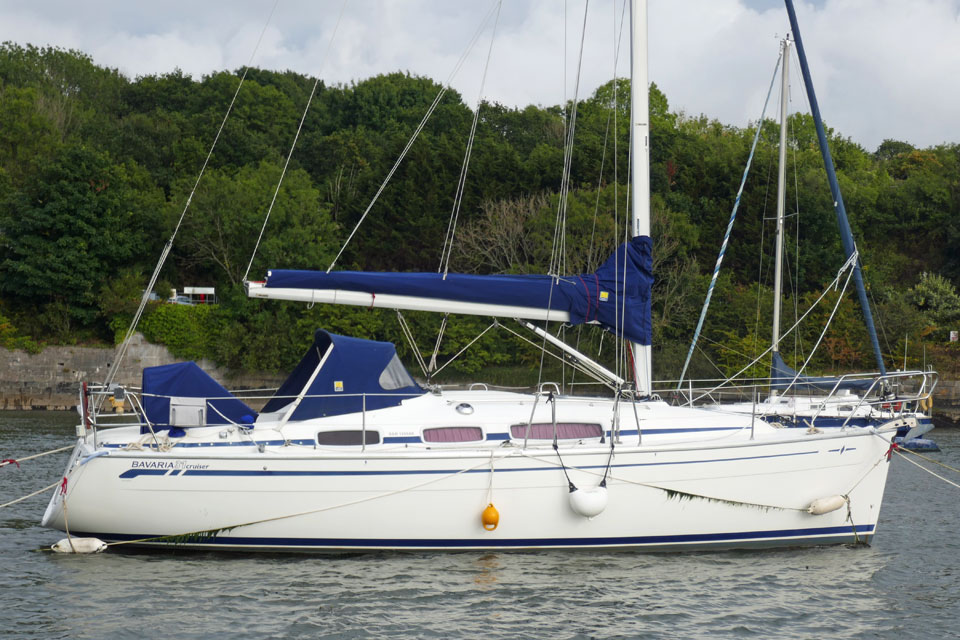
Westerly Kestrel 35
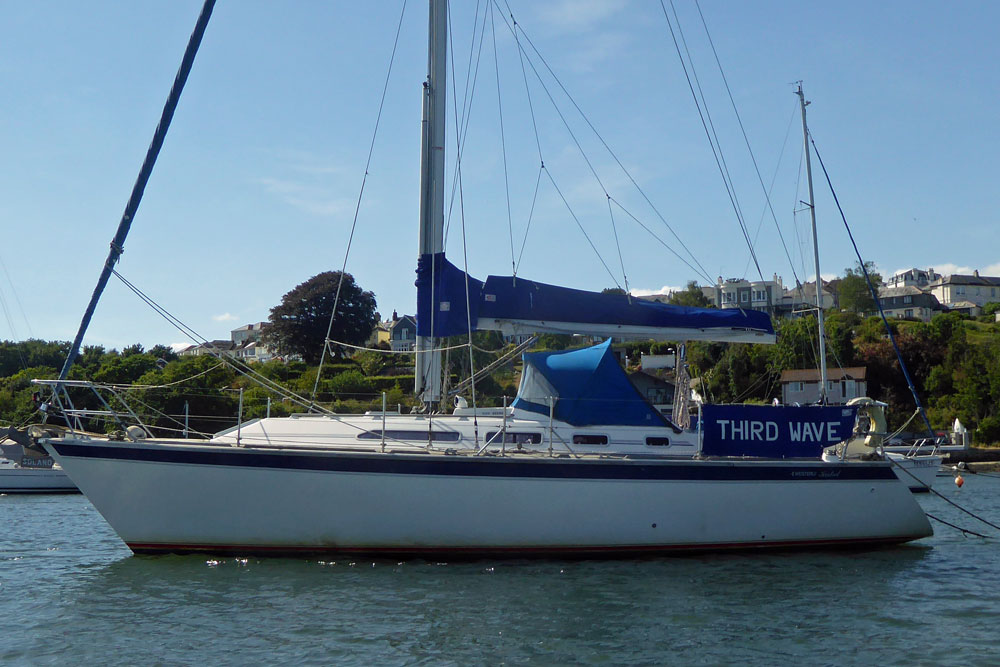
Westerly Berwick 31
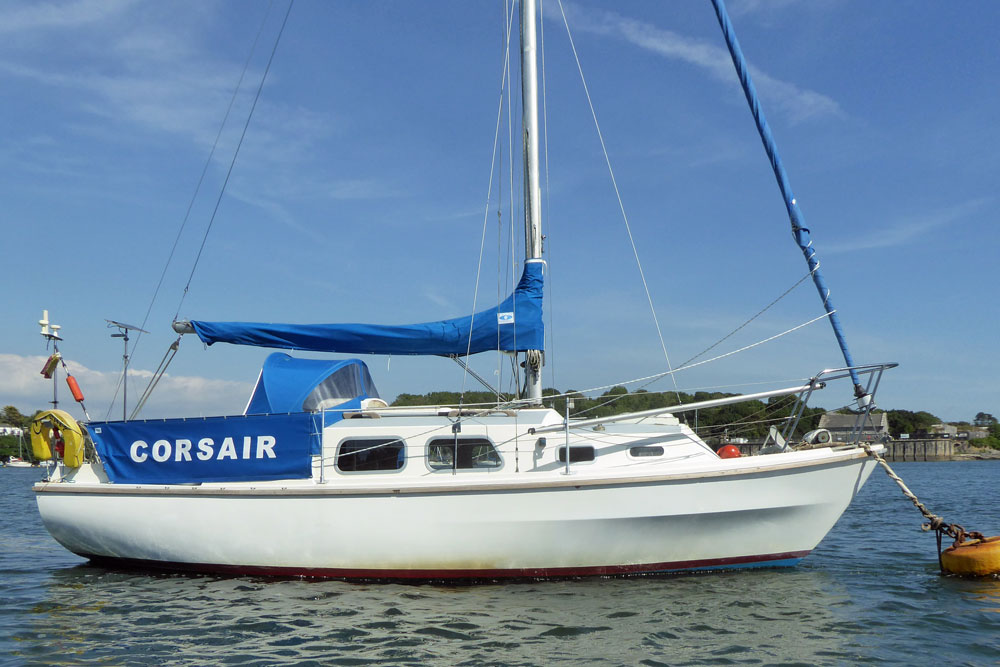
Dehler 35 CWS
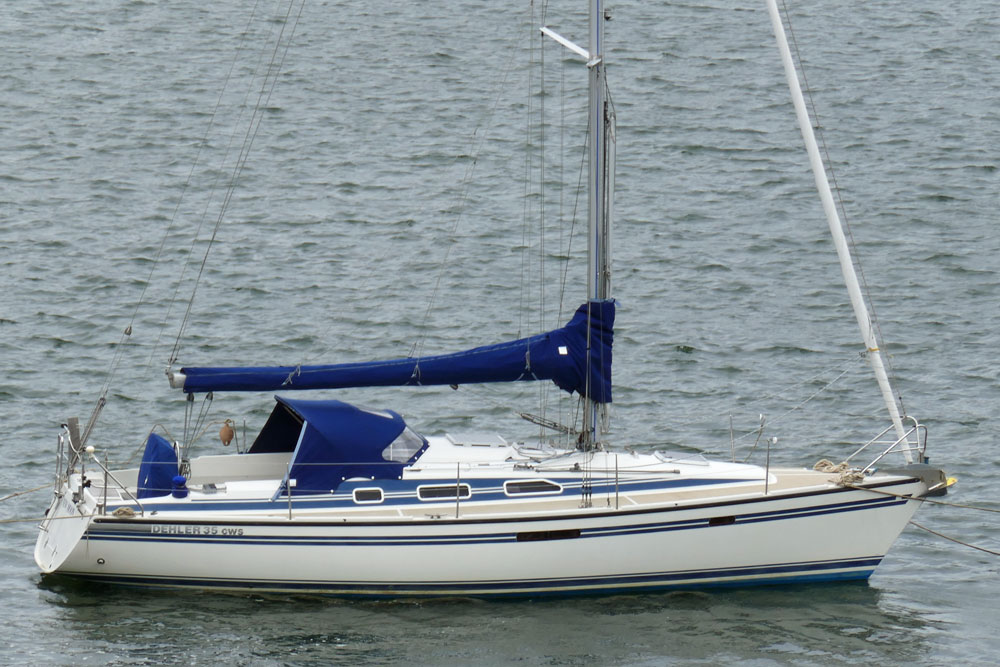
Westerly Vulcan 34
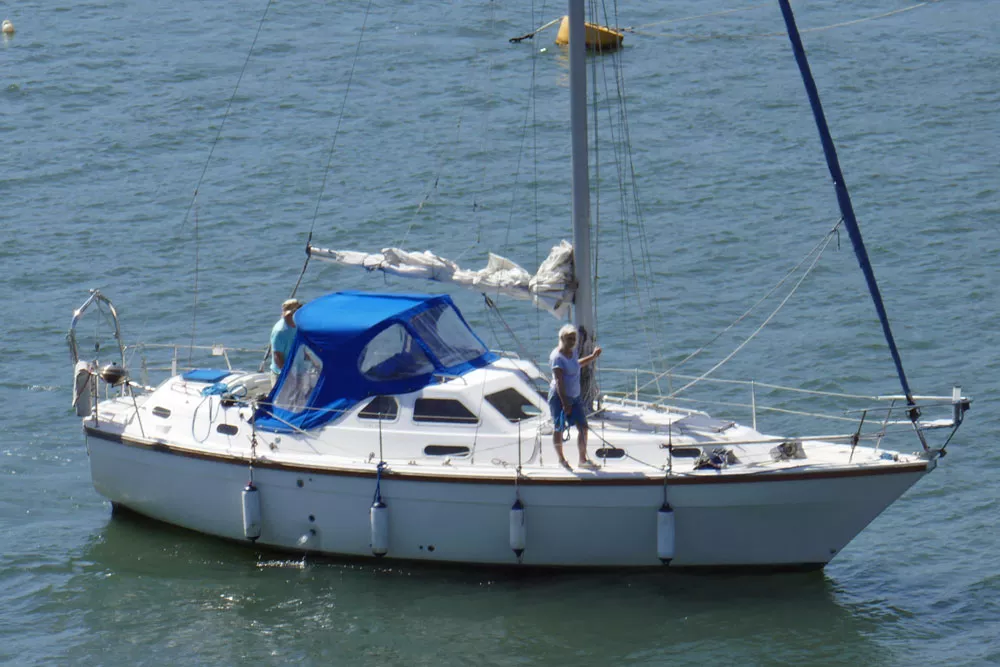
Jeanneau Sun Odyssey 32-1
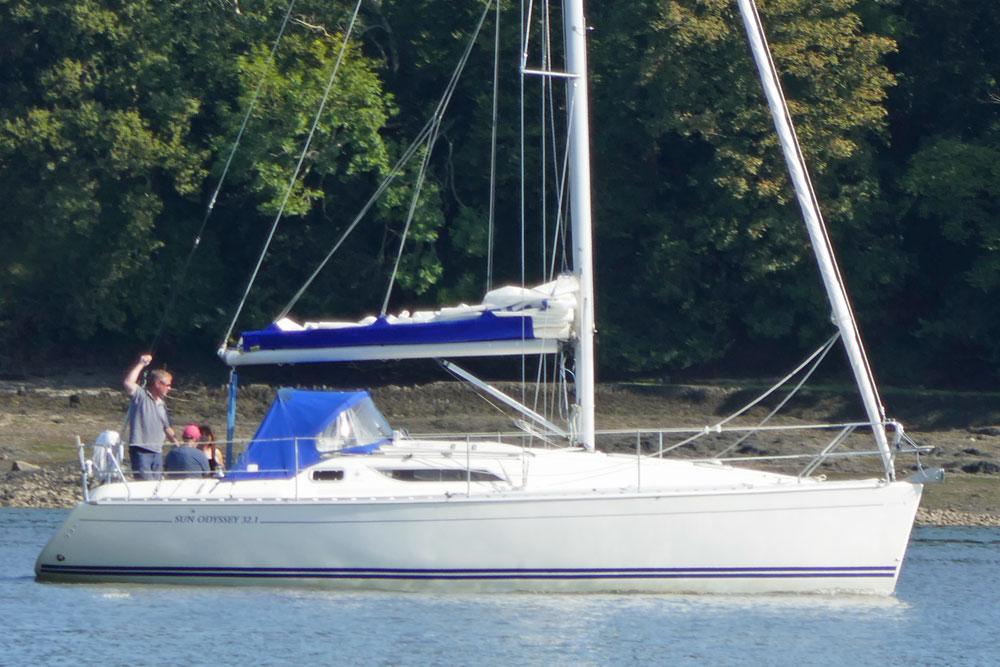
Elizabethan 33
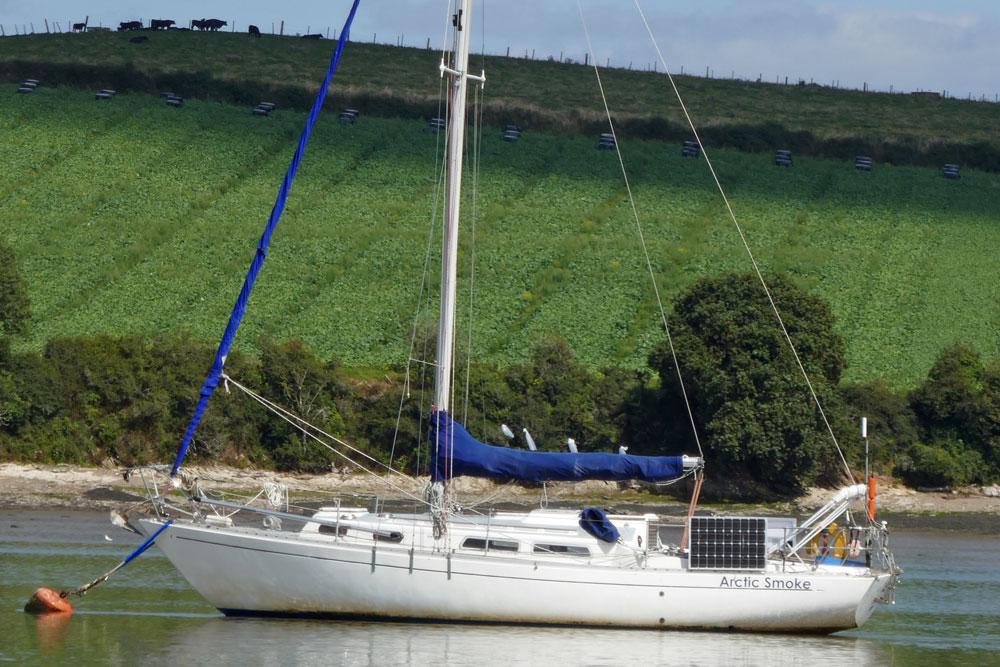
Westerly Seahawk 35
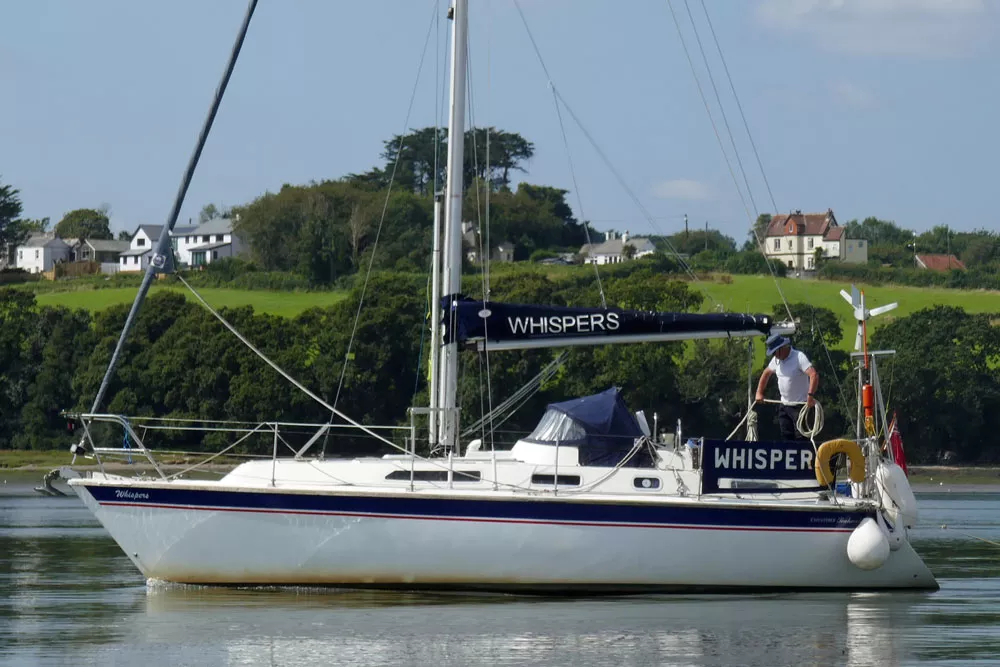
Nicholson 32
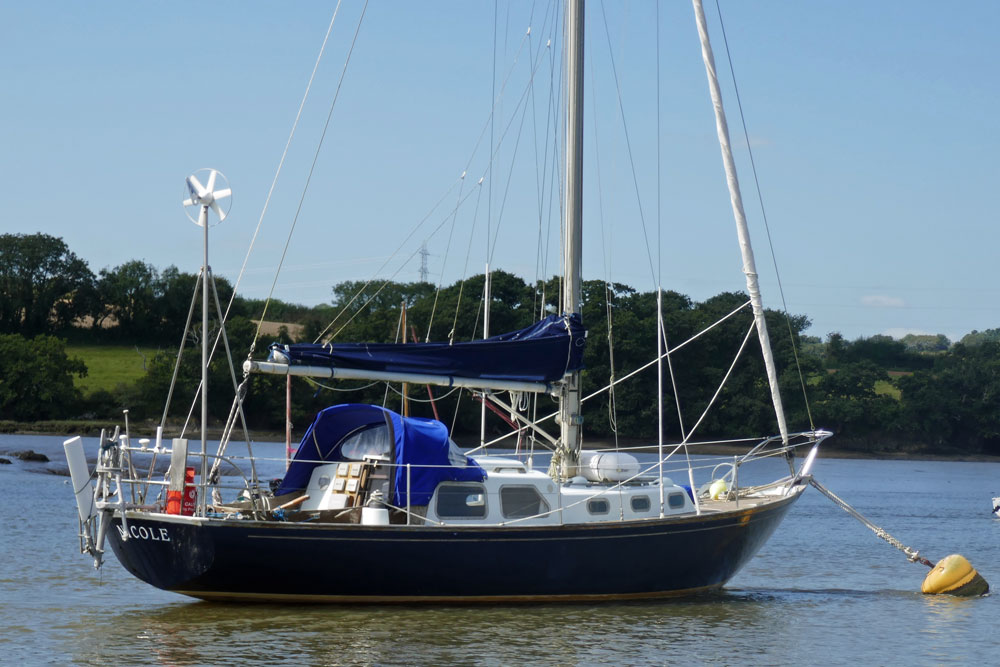
Westerly Ocean 33
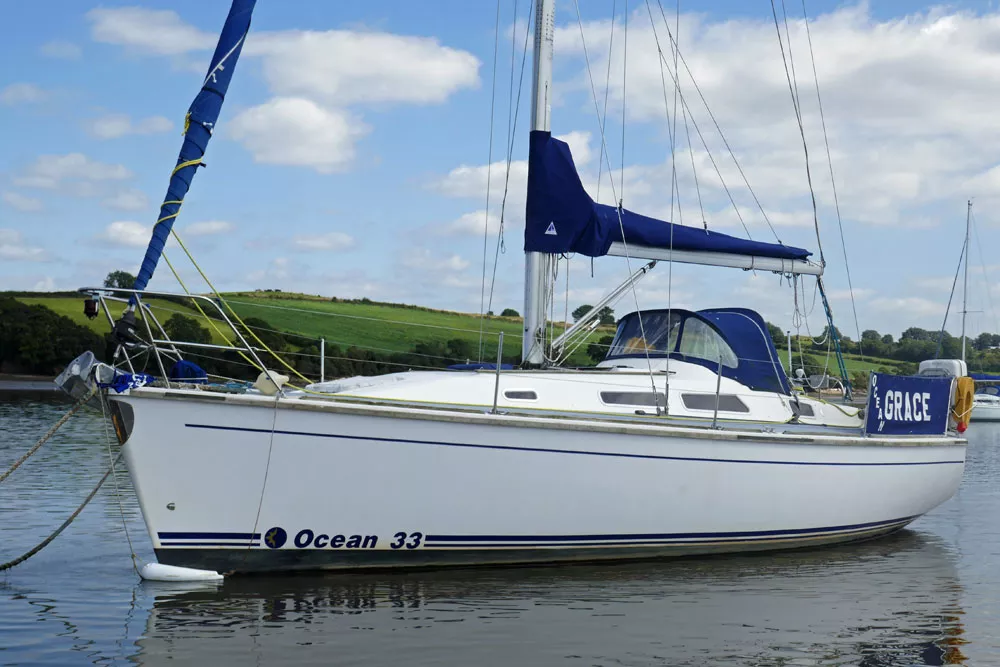
Hunter Channel 323
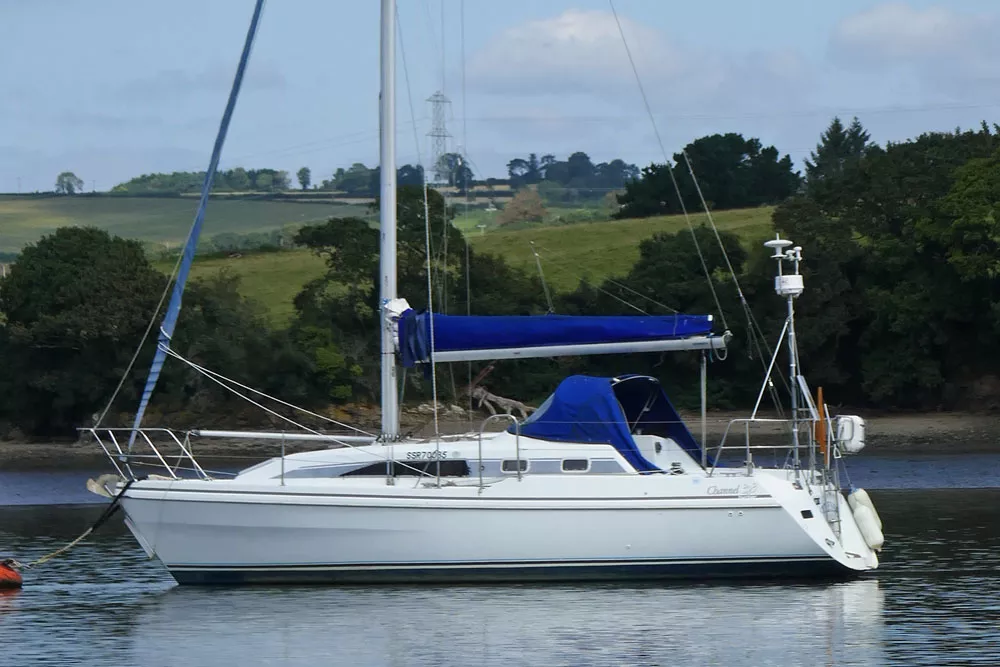
Island Packet 350
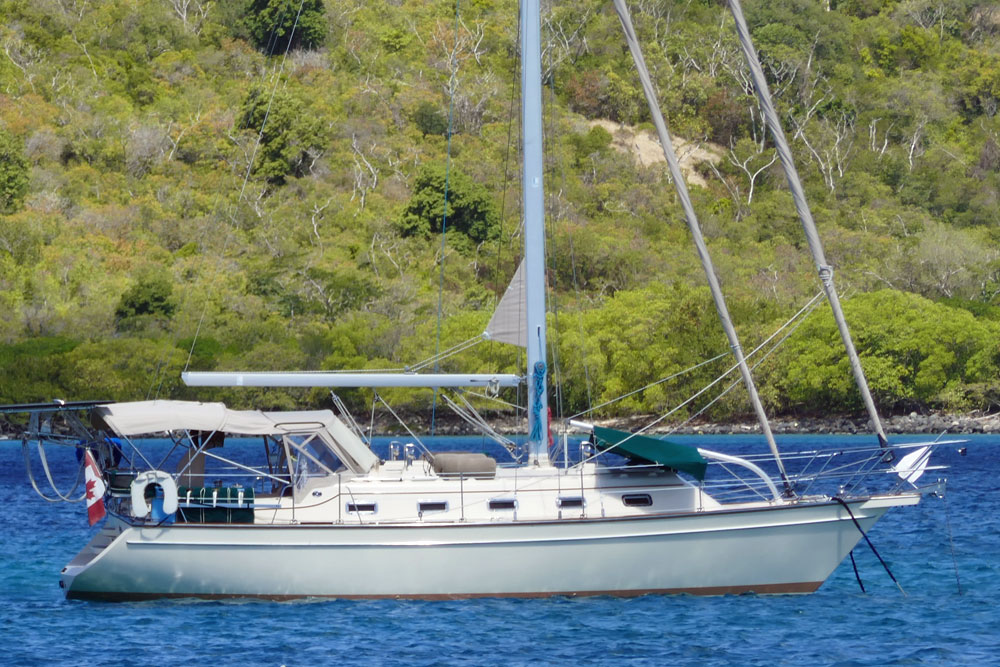
Corvette 31
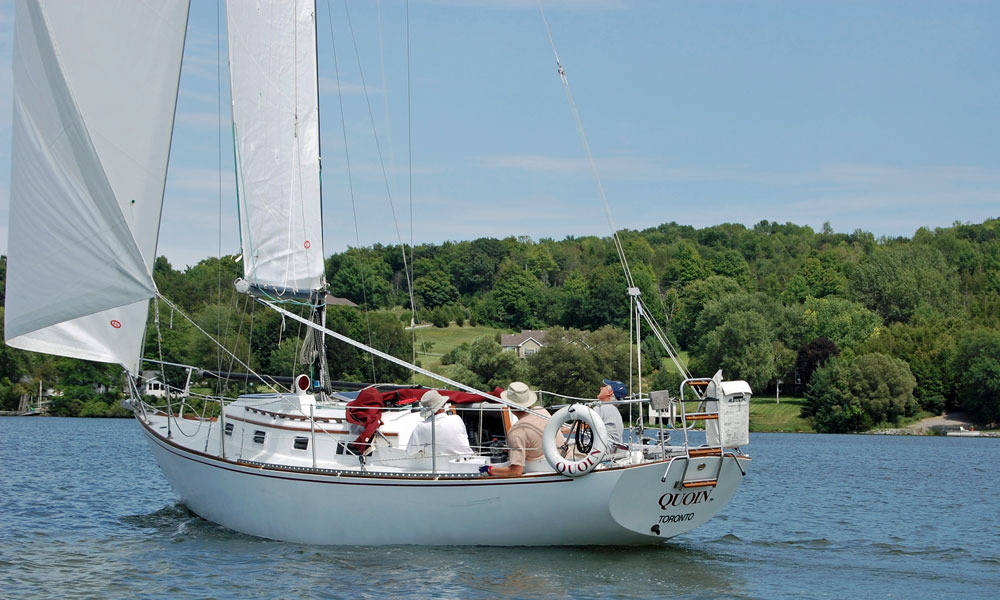
Beneteau Oceanis Clipper 343
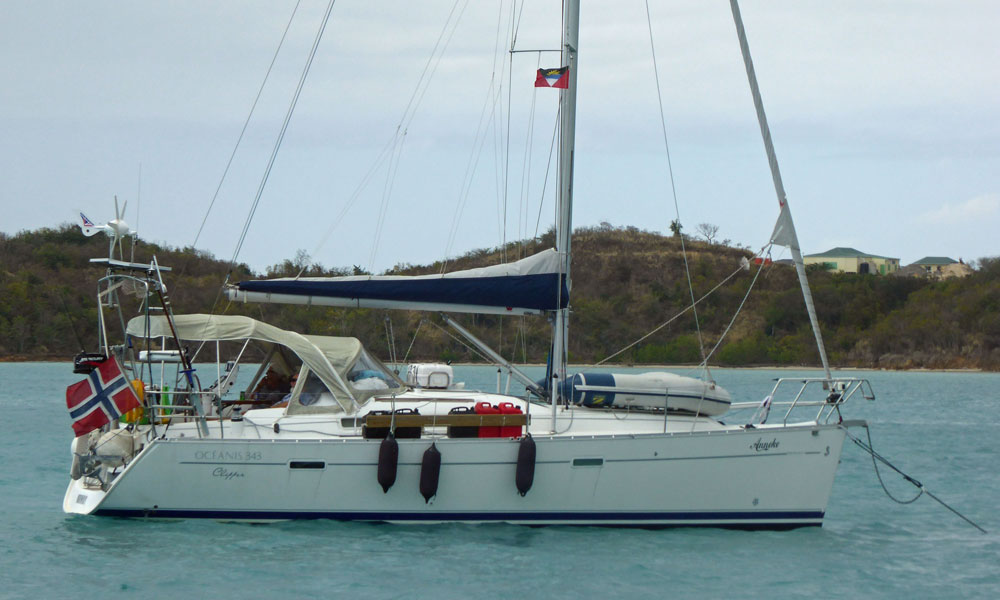
Hallberg-Rassy 94
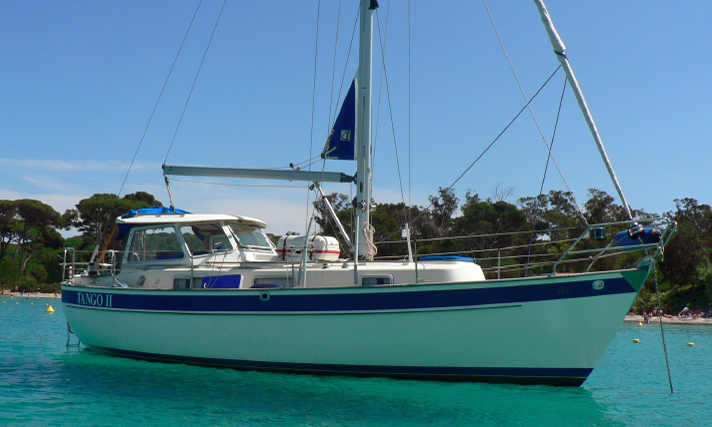
Many thanks to Richard Stuckey for the great pic of his cruising yacht 'Tango II' , shown here at anchor off Porqeurolles Island in the Mediterranean South of France.
Wauquiez Gladiateur 33
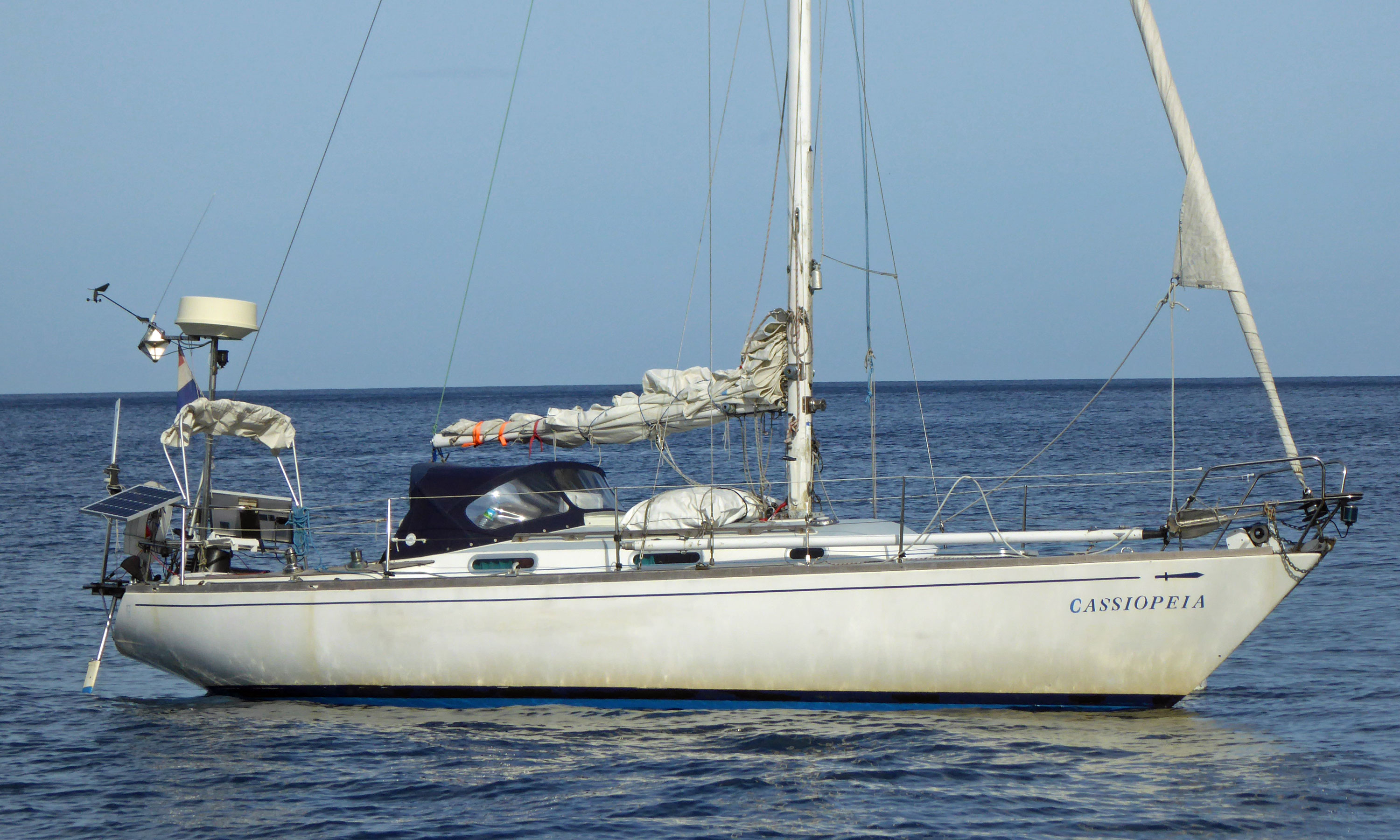
Jeanneau Attalia 32
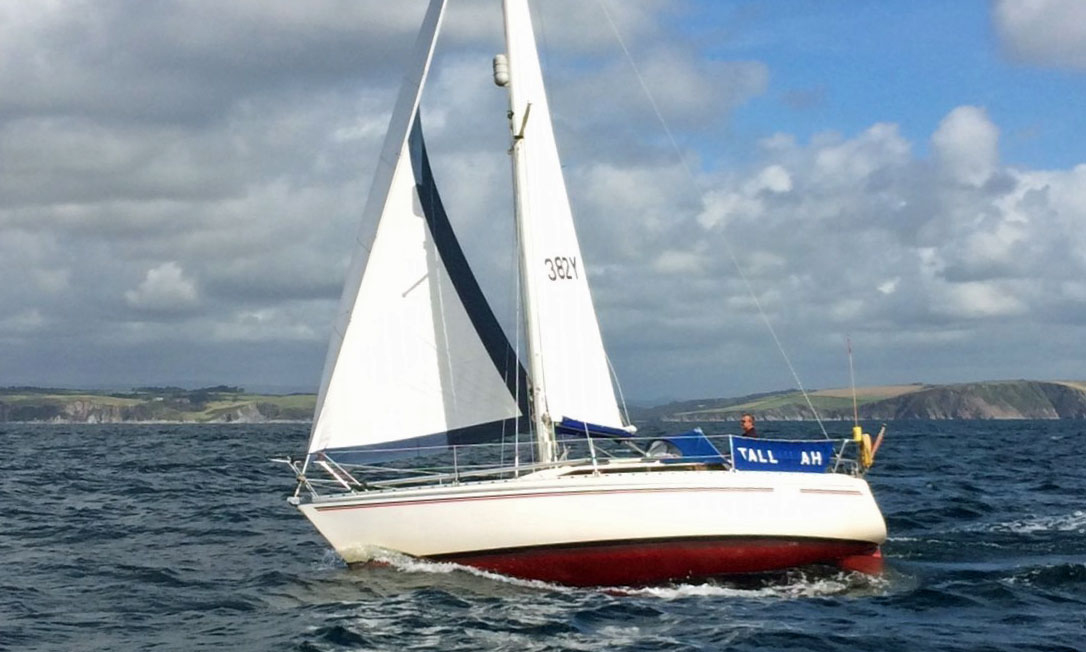
Thank you Paul Wright , for submitting this pic of your cruising yacht 'Tallulah'.
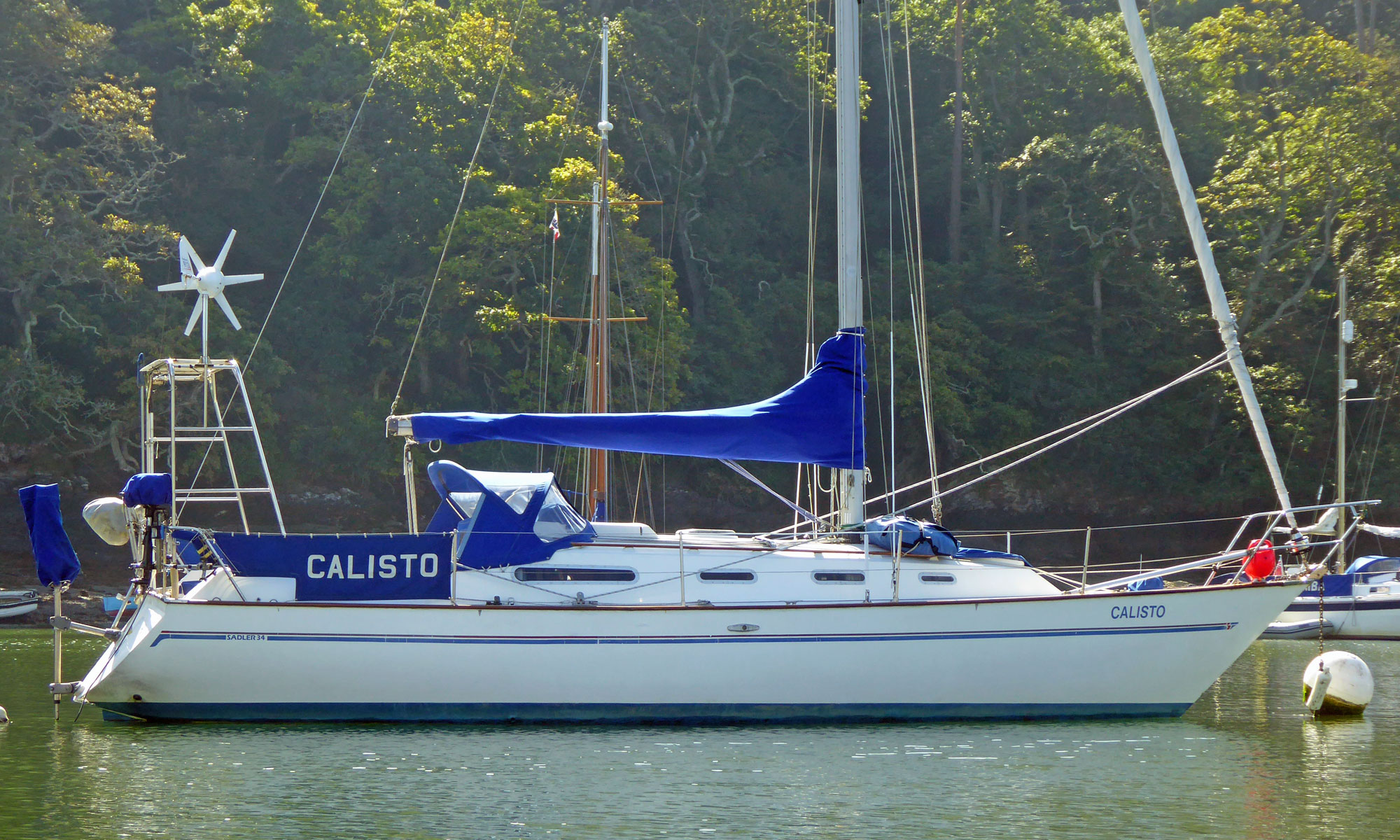
The owner of 'Second Star' tells us...
"This one is my Hunter 33e (now Marlow-Hunter 33e) "Second Star". The "e" stands for extended cockpit. It has a drop-down, walk-through transom that opens up the cockpit significantly and serves as a helm seat when up. I bought the boat new in 2014 and my longest cruise to date was from Annapolis MD to its slip in Alexandria, VA with my daughter. Of course, my intent is to take it on longer cruises like circling the DELMARVA peninsula, which would give me offshore time off the Delaware coast. It's a very comfortable cruising yacht of moderate size."
Aphrodite 101
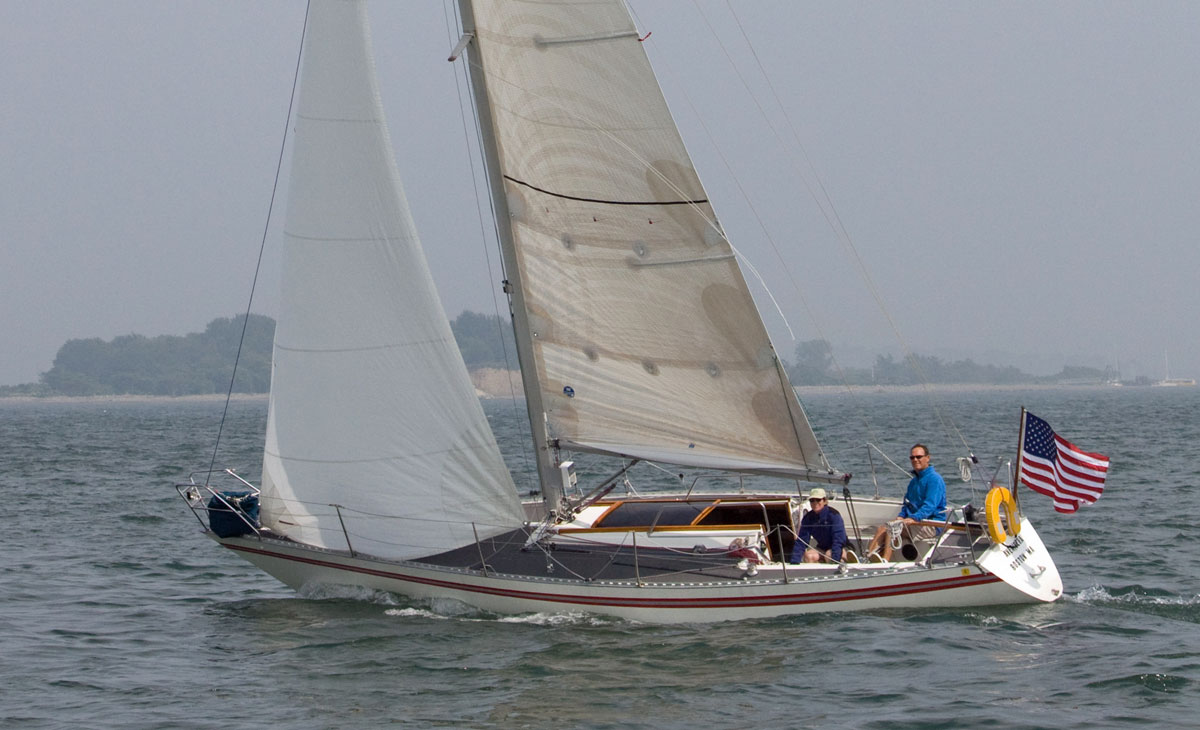
With their long, narrow and light hull and tall fractional rig these elegant sailboats have had many successful single and double-handed victories in distance races both coastal and offshore.
The owner of 'Averisera ' tells us:
"She has a very narrow hull with two good sea berths amidships. The galley is just aft of the berths, sink to starboard and cooker to port. Step down from companionway just aft of galley; seating to change into or out of wet gear without making sleeping area wet. Head all the way forward is OK but not great. Low free board means sink does not drain on port tack. Hull form is very, very sea kindly. Beautiful sailor, easy to steer in wide range of conditions and points of sail. For a small boat she is a competent cruising yacht."
Beneteau First 30E
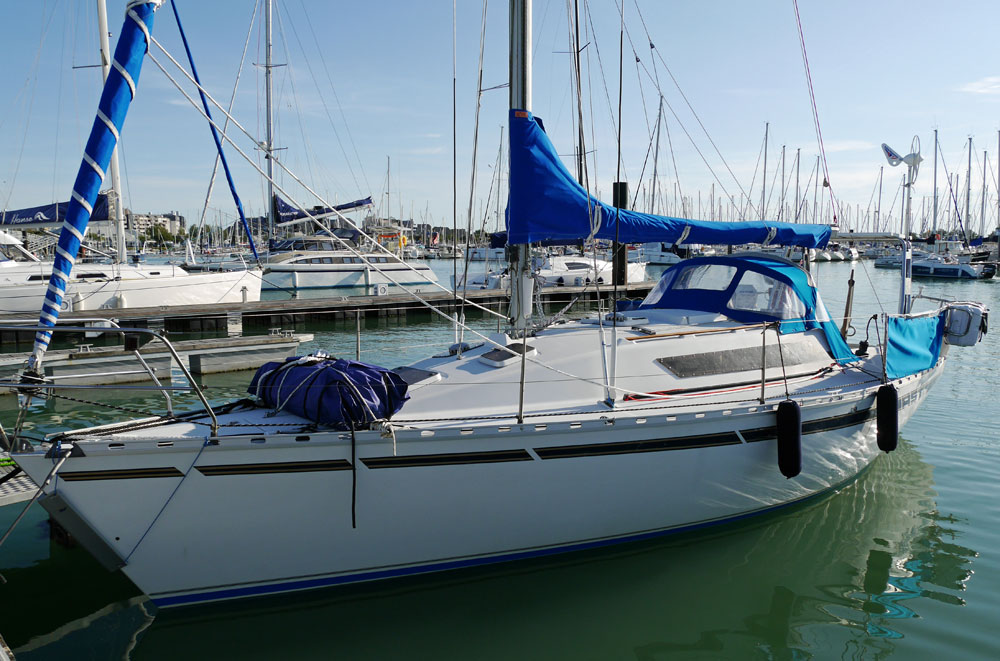
Westerly 33
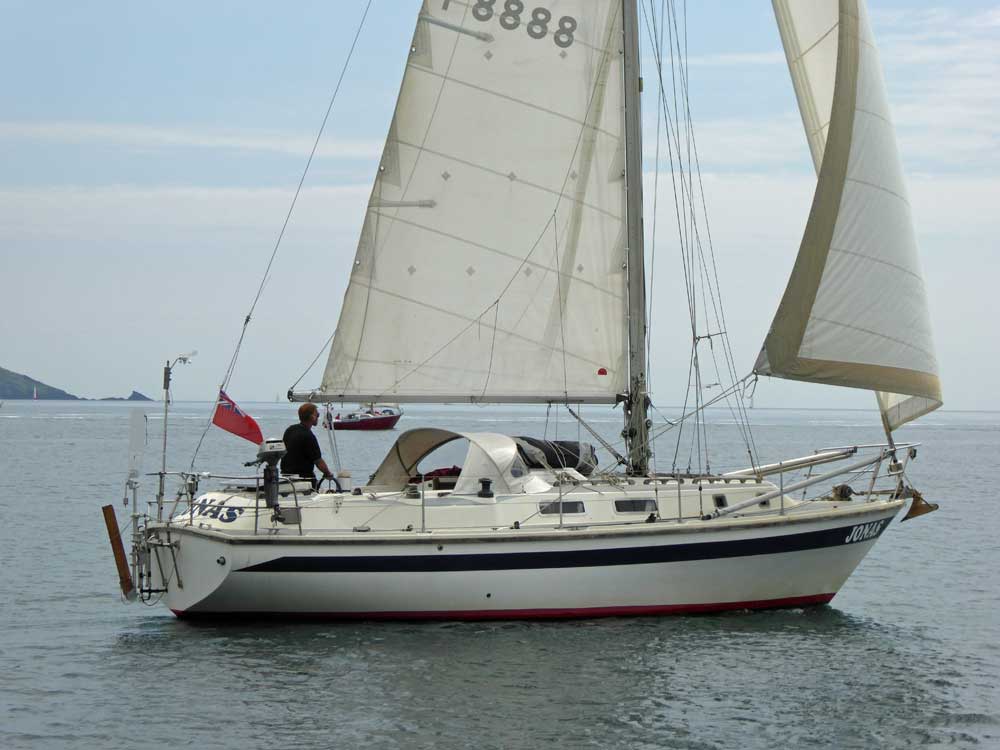
Have you got a cruising yacht in this size range?
If so, and you'd like to see an image of her on this page, please click here to send your pic to sailboat cruising.com and we'll do the rest.
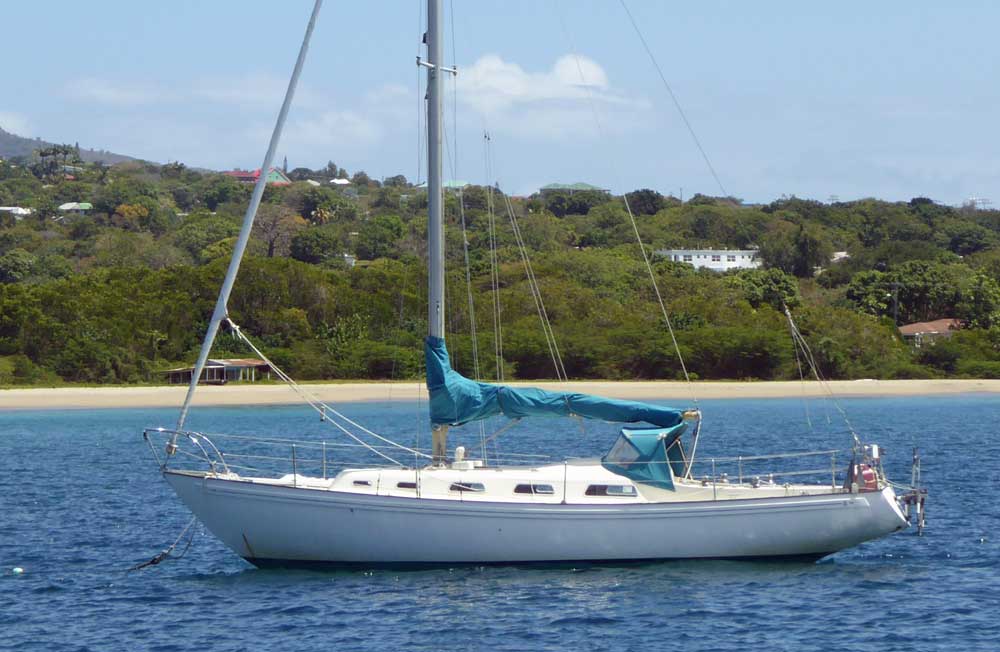
Albin Nova 32
Contessa 32.
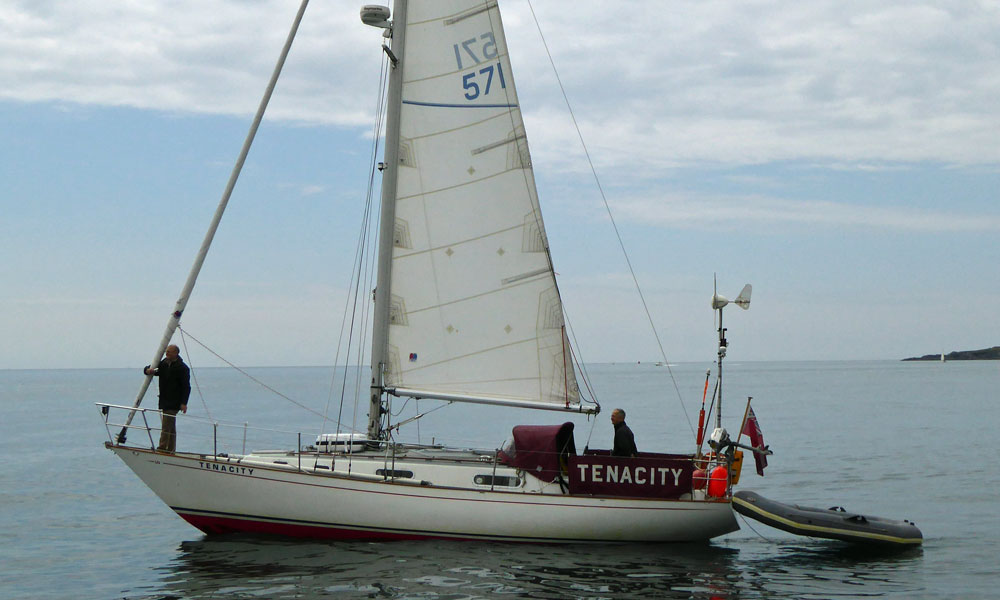
Nicholson 32 (Mark 10)
The Nicholson 32 Mk 10 cruising yacht in the pic is very dear to me; 'Jalingo 2' she's called - and I used to own her. Dick McClary, previous owner.
Westsail 32
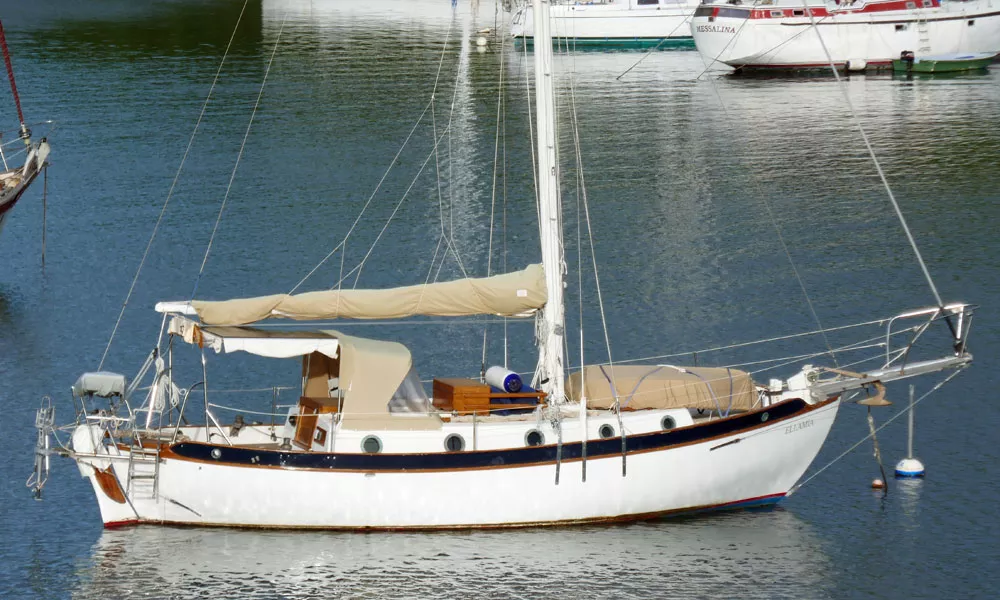
Southern Cross 31
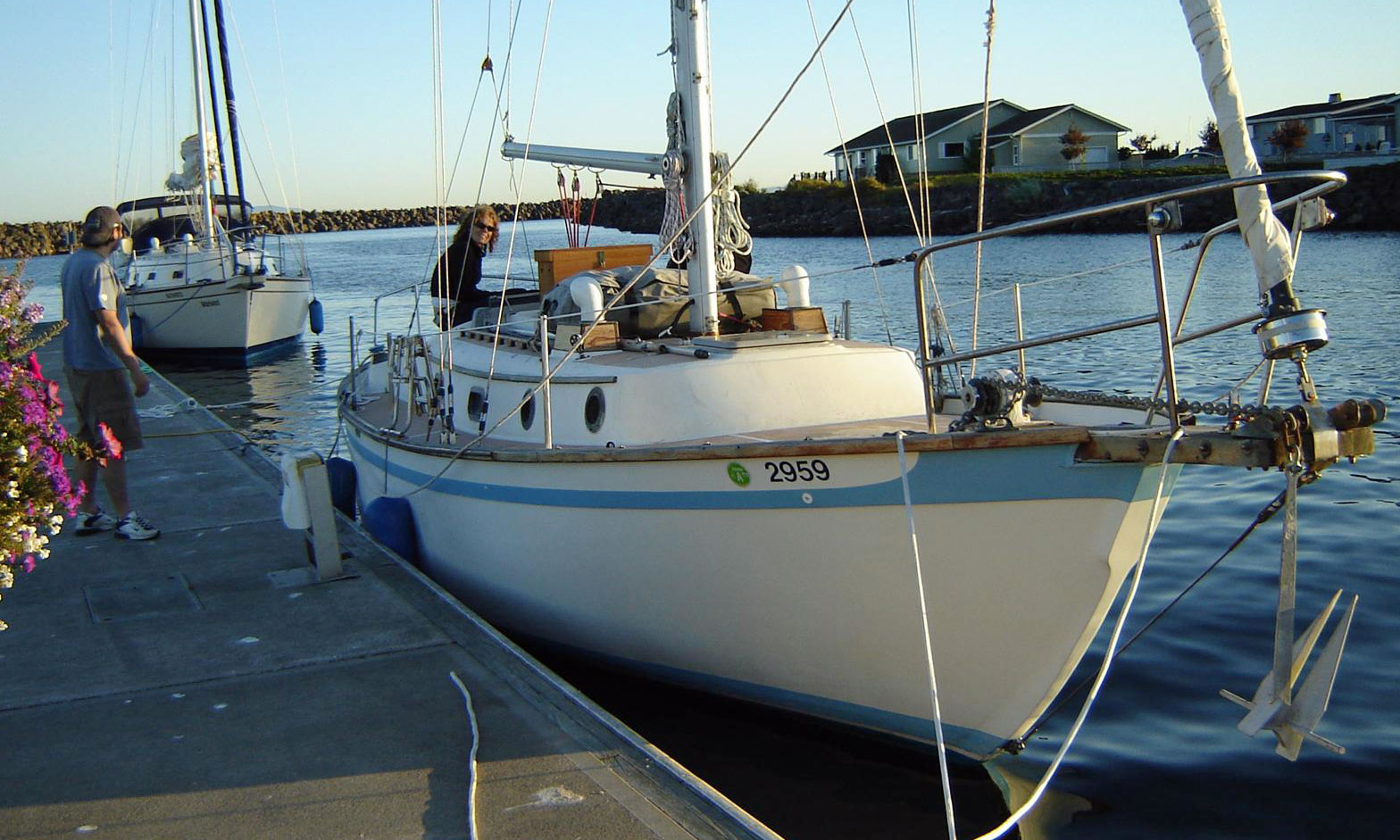
Thank you, Vern Bastable , for submitting this pic of your cruising yacht 'Mischief'.
Willard 30/8t
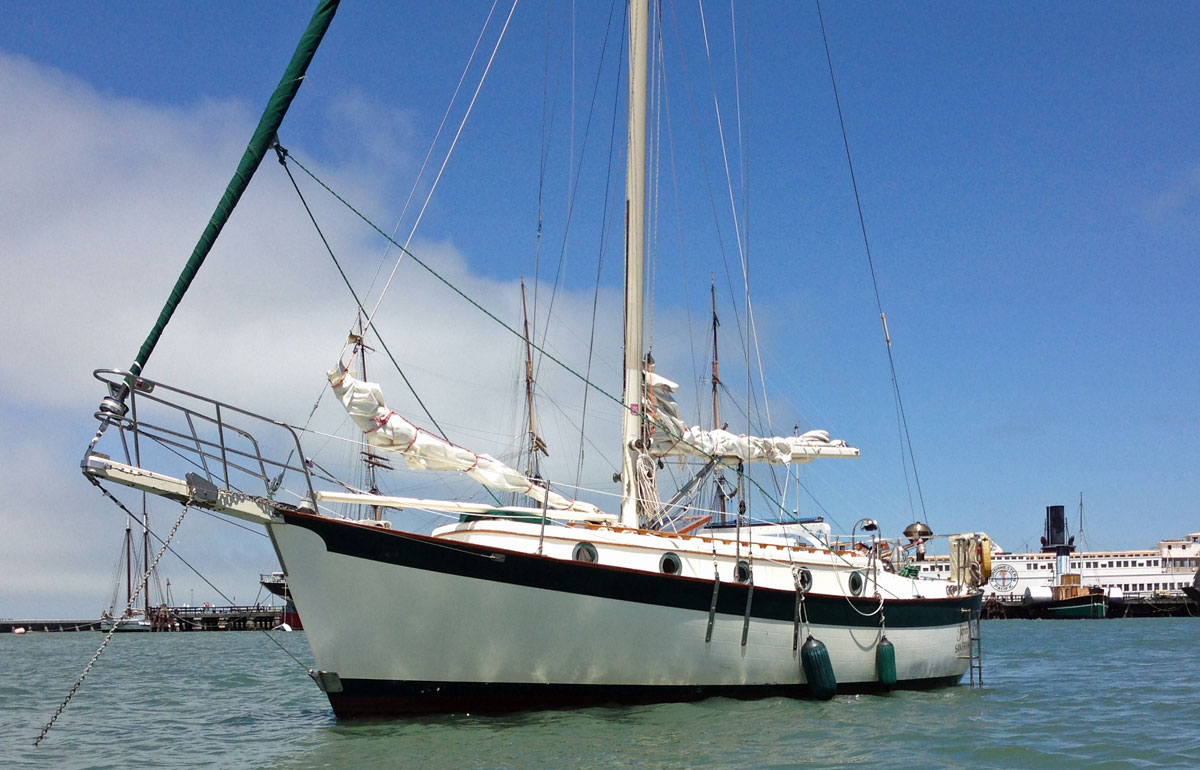
Vancouver 32
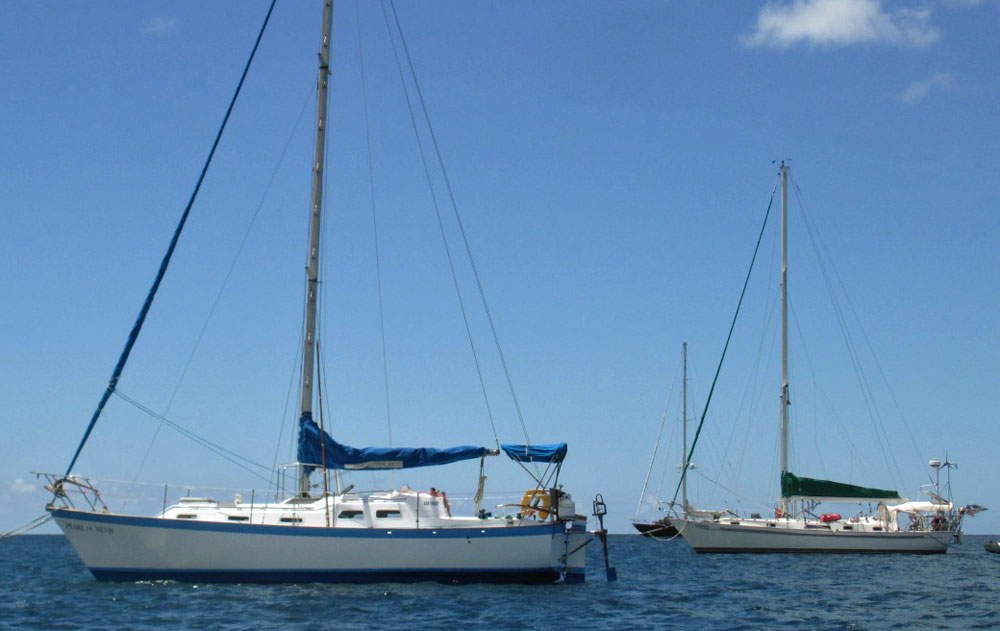
Nauticat 33
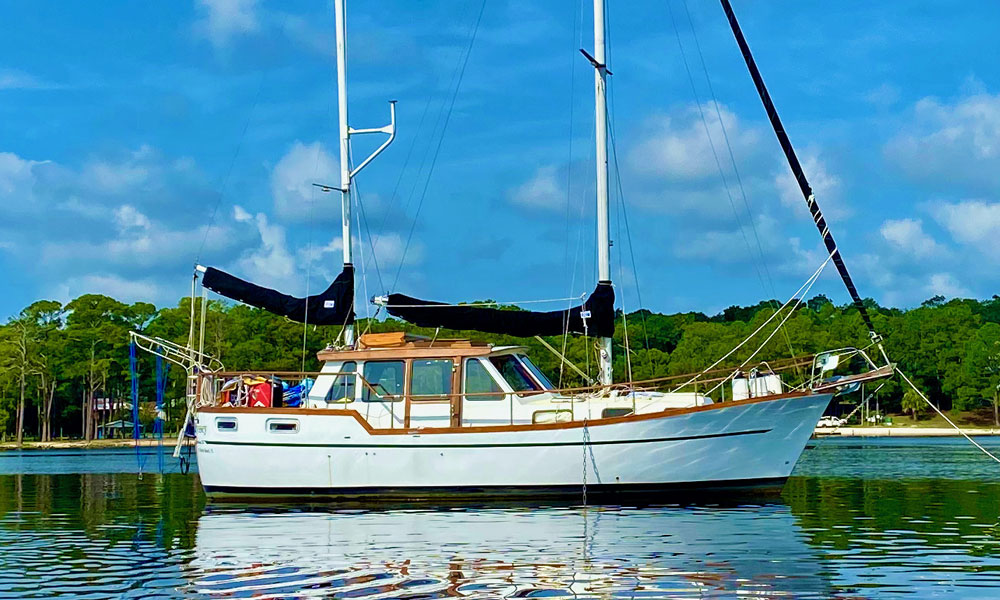
Thank you Phillip Caputo , for submitting this pic of your cruising yacht ' See Life ' .
Allied Seawind 30
Recent articles.
'Natalya', a Jeanneau Sun Odyssey 54DS for Sale
Mar 17, 24 04:07 PM
'Wahoo', a Hunter Passage 42 for Sale
Mar 17, 24 08:13 AM
Used Sailing Equipment For Sale
Feb 28, 24 05:58 AM
Here's where to:
- Find Used Sailboats for Sale...
- Find Used Sailing Gear for Sale...
- List your Sailboat for Sale...
- List your Used Sailing Gear...
- Sign-up for our newsletter, 'The Sailboat Cruiser' ...
- Identify this month's Mystery Boat...
Our eBooks...

A few of our Most Popular Pages...

Just a headsail and a mainsail - simple and efficient.
Read more...
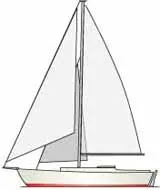
A smaller headsail and a staysail makes sail handling easier.
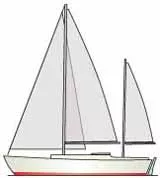
A second mast with a mizzen sail, for greater versatility.
Copyright © 2024 Dick McClary Sailboat-Cruising.com

How Tall Are Sailboat Masts? 9 Examples
The mast height of a sailboat varies with every model.
So what determines the height of a mast?
Here’s How Tall Sailboat Masts Are:
As a general rule of thumb, the height of a boat’s mast will be somewhere between 1.25 to 1.35 times the boat’s length, for an average of about 1.3 times the length overall (LOA) of the boat. An aspect of 2.5 or lower will be a low-aspect rig; above that is considered a high-aspect ratio.
Table of Contents

Understanding a Sailboat’s Mast and Rig
Sailboats are driven through the water by the power generated by their sails.
This is done using sail area. Sail area is calculated using the height of the mast and the length of the boom.
The battens, long strips of wood inserts in the sail, allow more sail area as they extend beyond a straight line from the head of the mast to the back of the boom, thus allowing more cloth to be carried.
Keep in mind that the mast height does not equal the luff length of the main; there is a distance between the deck and the top of the boom.
Most mains do not go all the way to the top of the boom mast.
Wind Gradient:
Designers are also aware of the wind gradient, meaning that as the wind blows over the water, the surface causes drag.
So the breeze is stronger the higher you get off of the surface.
Taller masts allow you to reach these stronger winds.
Mast Height:
While mast height is a prime determinant in the area, it is also possible to make a mast too tall so that the boat is always in danger of taking a knockdown.
Note there are some performance boats designed with masts that are too tall for the craft’s weight, assuming that the weight of the crew will balance out the sail area.
One thing to bear in mind here is a rig’s aspect ratio: this is determined by dividing the designed sail’s luff length by the length of the foot. An aspect of 2.5 or lower will be a low-aspect rig; above that is considered a high-aspect ratio.
Higher aspect boats perform better upwind; lower aspect ratios generally are more powerful in other wind conditions and are usually easier to control.
What’s the Average Height of Sailboat Masts?
Sailboats can range from 6 feet to a hundred or more feet in length if you throw out the multi-masted sailing ships of old.
The mast height for every single one is different.
The height of a mast is usually carefully calculated by figuring the amount of power needed to move a certain hull shape and weight through the water. In many cases, in the 1960s through the 1980s, some designers went by feel.
A few boatbuilders would use the same mast across several of their models to save money in some cases.
As a general rule of thumb, the height of a boat’s mast will be somewhere between 1.25 to 1.35 times the boat’s length, for an average of about 1.3 times the length overall (LOA) of the boat.
So, if you were going to average the mast heights of all 20-foot boats, you’d have about a 26-foot high mast and about 39 feet on 30-foot boats.
Boats built solely for cruising, particularly in offshore winds, will have shorter masts, and performance boats will have taller masts.
How do you Determine the Height of a Sailboat Mast?
Several factors determine a sailboat’s mast height.
A performance boat will have a higher aspect ratio for its sails and thus have a taller mast. Cruising boats will generally have smaller masts for the same length of the boat.
A wider and heavier boat than another boat will need more power to move it, so it will usually have a taller mast. If this heavy boat is a low-aspect-ratio rig designed for offshore work, it will probably have a comparably shorter mast for ease of handling in higher winds.
Conversely, a racing boat will be lighter but still have a taller mast to generate maximum power upwind.
Boats built for maximum performance will have very tall masts for their length and be very difficult to handle for an inexperienced crew – and sometimes for a trained, experienced crew as well, as the difficulties some of America’s Cup boats encounter demonstrate.
- The Melges 24 is a performance racer with a mast height of 31.4 feet for a head-to-head comparison. Her mainsail’s luff length is 28.92 feet, and the foot is 12.45 feet; she is a high-aspect-ratio boat.
- The Islander 24 has a mast height of 28.82, so it is 2 and 1/2 feet shorter than our Melges. The main’s luff length is 25.75 feet, and the foot is 11.52, for a low aspect ratio and much smaller main.
- The Islander 24 weighs 4,200 pounds, while the Melges 24 weighs less than 1,800 pounds.
How Tall is the Mast on a 40 ft Sailboat?
If a yawl or other rig with multiple masts, it will have shorter masts than a sloop.
If the boat is a fractional rig with a small foretriangle, like a modern high-aspect-ratio Hunter, the mast will be taller than another sloop of the same length:
- The old Tartan 40, an all-around great Sparkman & Stevens design from 1984, has a 51-foot mast. This is a classic racer/cruiser.
- The Nordic 40, designed around the same time, has a 52-foot mast.
- The Canadian-built C&C Crusader, designed in 1968, has a mast of 48 feet, but their later Mark 2 designs have masts of 53 to 55 feet in height.
These are all sloops. Ketch and yawl rigs will have masts shorter than this, as the smaller mizzens provide power (and helm balance).
So, this shows us that mast heights will fall into a range for any given length of the boat, again depending on other factors such as its function (primarily racing or cruising).
What is the Optimal Height of a Sailboat Mast?
As specified earlier, the designed height of a mast for any given sailboat generally falls between 1.25 and 1.35 times its length overall (as opposed to its waterline length).
The optimal height will be based on the designer’s calculations of the sail area and aspect ratio needed for the boat’s intended purpose. Beyond the simple racing/cruising divide, there are inshore and offshore cruisers and casual and serious racers.
Inshore cruising boats will generally be designed for maximum safety, and the mast height may be less than 1.25 times the length. Offshore cruisers may also be divided into casual and serious distance cruisers; a boat designed for better offshore cruising performance will have a taller mast.
It is unusual to find many cruising boats with a higher ratio than 1.3, however.
Racing boats will usually have a 1.35 ratio, though it can be as high as 1.5 or even higher at the extremes of the sport.
The mast height for America’s Cup AC50, a 50-foot catamaran, is 77 feet.
How Tall is the Tallest Sailboat Mast?
Two boats are currently competing for the title of having the world’s tallest mast.
Mirabella 5, now named M5 and launched in 2003, is the largest single-masted yacht ever built at 294 feet long.
Her mast is over 290 feet high.
The boom is nearly 90 feet in length. The mainsail has an area of 16,000 square feet! Her reacher (a large, light-weight genoa with some characteristics of a spinnaker), at 20,600 square feet, is the world’s largest sail.
The White Pearl, the world’s largest sailing yacht at nearly 350 feet, was launched in 2014. She has three carbon-fiber wing-style masts that are a little more than 90 meters high.
This puts the masts for the two yachts within a few feet of each other, though White Pearl gets the nod.
References:
Masts – Wikipedia
Sloops – Sailboat Cruising
World’s Tallest Carbon Fiber Masts
Click to share...
Great choice! Your favorites are temporarily saved for this session. Sign in to save them permanently, access them on any device, and receive relevant alerts.
- Sailboat Guide
Catalina 30
Catalina 30 is a 29 ′ 11 ″ / 9.1 m monohull sailboat designed by Frank V. Butler and built by Catalina Yachts between 1976 and 2008.

- 2 / 12 Freeport, TX, US 1979 Catalina 30 $20,000 USD View
- 3 / 12 Portland, OR, US 1979 Catalina 30 $24,900 USD View
- 4 / 12 Freeport, TX, US 1979 Catalina 30 $20,000 USD View
- 5 / 12 Freeport, TX, US 1979 Catalina 30 $20,000 USD View
- 6 / 12 Freeport, TX, US 1979 Catalina 30 $20,000 USD View
- 7 / 12 Freeport, TX, US 1979 Catalina 30 $20,000 USD View
- 8 / 12 Freeport, TX, US 1979 Catalina 30 $20,000 USD View
- 9 / 12 Freeport, TX, US 1979 Catalina 30 $20,000 USD View
- 10 / 12 Freeport, TX, US 1979 Catalina 30 $20,000 USD View
- 11 / 12 Freeport, TX, US 1979 Catalina 30 $20,000 USD View
- 12 / 12 Freeport, TX, US 1979 Catalina 30 $20,000 USD View
Rig and Sails
Auxilary power, accomodations, calculations.
The theoretical maximum speed that a displacement hull can move efficiently through the water is determined by it's waterline length and displacement. It may be unable to reach this speed if the boat is underpowered or heavily loaded, though it may exceed this speed given enough power. Read more.
Classic hull speed formula:
Hull Speed = 1.34 x √LWL
Max Speed/Length ratio = 8.26 ÷ Displacement/Length ratio .311 Hull Speed = Max Speed/Length ratio x √LWL
Sail Area / Displacement Ratio
A measure of the power of the sails relative to the weight of the boat. The higher the number, the higher the performance, but the harder the boat will be to handle. This ratio is a "non-dimensional" value that facilitates comparisons between boats of different types and sizes. Read more.
SA/D = SA ÷ (D ÷ 64) 2/3
- SA : Sail area in square feet, derived by adding the mainsail area to 100% of the foretriangle area (the lateral area above the deck between the mast and the forestay).
- D : Displacement in pounds.
Ballast / Displacement Ratio
A measure of the stability of a boat's hull that suggests how well a monohull will stand up to its sails. The ballast displacement ratio indicates how much of the weight of a boat is placed for maximum stability against capsizing and is an indicator of stiffness and resistance to capsize.
Ballast / Displacement * 100
Displacement / Length Ratio
A measure of the weight of the boat relative to it's length at the waterline. The higher a boat’s D/L ratio, the more easily it will carry a load and the more comfortable its motion will be. The lower a boat's ratio is, the less power it takes to drive the boat to its nominal hull speed or beyond. Read more.
D/L = (D ÷ 2240) ÷ (0.01 x LWL)³
- D: Displacement of the boat in pounds.
- LWL: Waterline length in feet
Comfort Ratio
This ratio assess how quickly and abruptly a boat’s hull reacts to waves in a significant seaway, these being the elements of a boat’s motion most likely to cause seasickness. Read more.
Comfort ratio = D ÷ (.65 x (.7 LWL + .3 LOA) x Beam 1.33 )
- D: Displacement of the boat in pounds
- LOA: Length overall in feet
- Beam: Width of boat at the widest point in feet
Capsize Screening Formula
This formula attempts to indicate whether a given boat might be too wide and light to readily right itself after being overturned in extreme conditions. Read more.
CSV = Beam ÷ ³√(D / 64)
With more than 6000 sold, the Catalina 30 is one of the most successful production sailing yachts in history. During the long production run of this basic model there were a great number of variations with standard and tall rig configurations, each with a bowsprit option, and also including shoal, wing and deep fin keels. A MK II version began around hull# 3300 (1986).(T-shaped cockpit is the most notable change) The Mark III (1994) (walk-thru transom with boarding/swim platform standard though offered as an option on earlier models.) Aux. power: The early Yanmar, Universal 5411 and Atomic-4 engines were phased out in favor of the 3-cylinder Universal M-25 diesels during the middle 80s.
SHOAL DRAFT: 4.30’/1.31m SHOAL DRAFT (WING): 3.83’/1.17m
ALT.RIG DIMENSIONS: TALL: I: 43.00’/13.11m J: 13.15’/4.01m P: 37.50’/11.43m E: 12.00’/3.66m SA (100%): 507.73ft2/47.17m2
BOWSPRIT OPTION (STD): I: 41.00’/12.50m J: 13.15’/4.01m P: 37.00’/11.28m E: 12.00’/3.66m SA (100%): 491.58ft2/45.67m2 (photo from Catalina brochure)
Embed this page on your own website by copying and pasting this code.

Discover Related Sailboats

Cruising World: 40 Best Sailboats
Cruising World polled their readers to determine the best sailboats of all time.

Catalina 30 MKIII
- About Sailboat Guide
©2024 Sea Time Tech, LLC
This site is protected by reCAPTCHA and the Google Privacy Policy and Terms of Service apply.

Catalina 30 MkII Tall rig
Sailboat specifications.
- Last update: 25th March 2020
Catalina 30 MkII's main features
Catalina 30 mkii's main dimensions, catalina 30 mkii's rig and sails, catalina 30 mkii's performances, catalina 30 mkii's auxiliary engine, catalina 30 mkii's accommodations and layout.
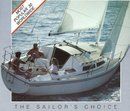
Similar sailboats that may interest you:
- New Sailboats
- Sailboats 21-30ft
- Sailboats 31-35ft
- Sailboats 36-40ft
- Sailboats Over 40ft
- Sailboats Under 21feet
- used_sailboats
- Apps and Computer Programs
- Communications
- Fishfinders
- Handheld Electronics
- Plotters MFDS Rradar
- Wind, Speed & Depth Instruments
- Anchoring Mooring
- Running Rigging
- Sails Canvas
- Standing Rigging
- Diesel Engines
- Off Grid Energy
- Cleaning Waxing
- DIY Projects
- Repair, Tools & Materials
- Spare Parts
- Tools & Gadgets
- Cabin Comfort
- Ventilation
- Footwear Apparel
- Foul Weather Gear
- Mailport & PS Advisor
- Inside Practical Sailor Blog
- Activate My Web Access
- Reset Password
- Pay My Bill
- Customer Service

- Free Newsletter
- Give a Gift

How to Sell Your Boat

Cal 2-46: A Venerable Lapworth Design Brought Up to Date

Rhumb Lines: Show Highlights from Annapolis

Open Transom Pros and Cons

Leaping Into Lithium

The Importance of Sea State in Weather Planning

Do-it-yourself Electrical System Survey and Inspection

Install a Standalone Sounder Without Drilling

Rethinking MOB Prevention

Top-notch Wind Indicators

The Everlasting Multihull Trampoline

In Search of the Snag-free Clew

What’s Involved in Setting Up a Lithium Battery System?

Reducing Engine Room Noise

Breaking Point: What Can Go Wrong With Your Yanmar?

Mildew-resistant Caulks for Boats

Can We Trust Plastic Boat Parts?

Repairing Molded Plastics

Mailport: Marine plywood, fuel additives, through bolt options, winch handle holders

The Day Sailor’s First-Aid Kit

Choosing and Securing Seat Cushions

Cockpit Drains on Race Boats

Rhumb Lines: Livin’ the Wharf Rat Life

Safer Sailing: Add Leg Loops to Your Harness

Resurrecting Slippery Boat Shoes

Tricks and Tips to Forming Do-it-yourself Rigging Terminals

Marine Toilet Maintenance Tips

Learning to Live with Plastic Boat Bits

The Ultimate Guide to Caring for Clear Plastic
- Belowdecks & Amenities
- Boat Maintenance
- Sailboat Reviews
- Sails, Rigging & Deck Gear
- Systems & Propulsion
Improve Your Catalina 30: Upgrading the World’s Most Popular 30-Footer
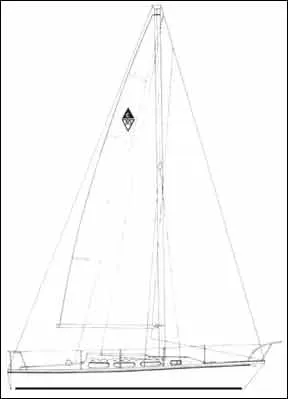
The Catalina 30 is a remarkable success story. We suspect that more Catalina 30s have been built than any other boat of that size anywhere in the world. While the basic boat has remained unchanged since it was introduced in 1975, there have been dozens, perhaps even hundreds, of minor developments in the boat in the course of a production run that is approaching 4,000 hulls.
The advantage of a boat in production for so long is a high degree of product refinement over the years. The challenge for the owner of an early version of the boat is to upgrade his boat to the standards of models currently in production.
In the case of the Catalina 30, a number of bulletins have been published by the builder over the years, detailing improvements to the boat. In addition, there is an active owners’ association, and many individual owners have embarked on significant programs of upgrading their boats.
As a rule, the changes to the boat over the years of production have been true improvements. At least one change, however, was less successful. The original changeover to diesel power resulted in a boat that was significantly underpowered, according to many owners.
Almost all the suggestions presented here for the upgrading of the Catalina 30 come from owners. Over 80 responded to the detailed questionnaire about the boat, and many added more pages of comments to the responses. The owners responding own boats that run the gamut of the production history of the Catalina 30, from hull number 2 to hull numbers well over 3,000!
Here, then are the suggestions of Catalina 30 owners for the improvement of the world’s most popular 30-footer. Not all will be applicable to any particular hull. Many of the changes suggested or performed by owners of early boats were incorporated into the production of later boats. In addition, some of the changes became factory retrofits, so that some older boats have been upgraded to the specifications of newer models.
Hull and Construction Details
Until very recently, all through hulls in the boat below the waterline consisted of gate valves screwed onto pipes fiberglassed into the hull. Current models utilize RC synthetic seacocks incorporating recessed through hull fittings.
The advantage of the old system is that there is no exposed, drag-inducing external skin fitting. The disadvantage is that gate valves are a generally poor substitute for seacocks, since it is not always possible to determine if they are open or closed, they can be jammed in the open position by debris, and they are as a rule more subject to corrosion.
Replacement of the gate valves with proper seacocks, either of tapered plug or ball valve construction, is recommended. Proper skin fittings should be installed at the same time, and these can either be faired in externally, or recessed (see Better Boat, February 1984).
As a rule, deck hardware is installed with large washers, but without proper backup plates. Stanchions, pulpits, and cleats can be made stronger by the addition of aluminum backup plates to help distribute load.
Like many other builders, Catalina has finally abandoned running lights mounted in the topsides. If being seen at night is a priority, install a pulpit-mounted combination running light, as is used in current production models of the Catalina 30.
Generally a little more attention to bottom detailing on the Catalina 30 should get you a little more speed. The rather large gap between the skeg and rudder should be filled in with fairing flaps to reduce crossflow. This improvement, suited to many boats, will be detailed in a future issue. In addition, lines and seaweed can jam between the forward part of the rudder blade and the bottom of the skeg. A deflecting rod, perhaps a piece of 5 11 6″ diameter bronze rod, can be glassed into the bottom of the skeg, just overlapping the opening between the rudder blade and the bottom of the skeg. In New England, this type of rudder/skeg configuration, without the deflector, is known as a potcatcher because of the amount of lobster pot warp that can lodge in the opening.
Prop skeg configuration has changed slightly over the years, but as a rule, the skegs are fairly clean airfoil bronze castings. On the new Catalina 30s we examined, the casting was quite rough, however, and would benefit from a touchup coat of epoxy and microballoons, followed by a thorough sanding to smooth it out.
Prop wash when under power can make the Catalina 30 a bear to handle for extended periods. The original rudder was redesigned, and many older boats have been retrofitted with the improved rudder which greatly reduced the helm problem. If you bought your Catalina 30 used, and find the helm excessively heavy when powering, contact Catalina for information on the new rudder. If in doubt, send a photograph of your rudder to the company. Theyll tell you whether you have the new or old version.
Rig The rig of the Catalina 30 is decidely old fashioned, with its untapered mast tube, wooden spreaders, and unanodized mast and boom. Mast and boom should be painted, both to reduce surface oxidation and improve appearance.
Standing rigging, chainplates, and rigging fittings bring negative comments from a surprising number of owners, who consider this part of the boat a weak point. Beef-up kits for lower shrouds are available from the builder at nominal cost, and most older boats have had this modification If you have an older boat and don’t know, compare your boat to a recent model nearby or take a picture and send it to the builder.
If you have closed body, stainless steel turnbuckles, replace them with open body turnbuckles of bronze, chromed bronze, or mixed bronze/stainless steel construction. Steel on steel turnbuckles have a nasty habit of seizing, and the closed body makes its difficult to judge the amount of adjustment left in the screw.
The small diameter wire used for shrouds and stays stretches excessively, according to some owners, making it difficult to maintain headstay tension. Going up one wire diameter, at least on forestay and backstay, is suggested by many owners.
Although it is rarely mentioned by owners, we would suggest replacing the wooden spreaders with airfoil aluminum spreaders.
Internal halyards, led aft along the cabin top to the cockpit, are a popular modification. There is just enough room between the forward edge of the seahood and the cabintop handrail to put turning blocks on the deck for the halyards. Be sure to stagger the halyard exit holes on the mast, and fit them with chafe guards to keep the halyard wires from eating into the mast tube.
The boat quickly develops weather helm as it heels, a not uncommon trait of wide boats such as the Catalina 30. Even sailing upright on a broad reach, there is a fair amount of weather helm. This is minimized with the tall rig/bowsprit option, and can be reduced on the standard rig by raking the mast forward slightly, and having the mainsail cut with minimum roach. Unfortunately, reducing the roach gives away sail area that the boat may need in light air. We see no reason why the bowsprit couldnt be added to the standard rig boat to move the center of effort of the sail plan further forward. This will, of course, increase the boats rating under any racing rule.
Although the shrouds are set well inboard, the genoa track is mounted atop the toerail. This may be fine for reaching, but it leaves too wide a sheeting angle for going upwind, according to owners. Installing a genoa track inboard, between the stanchions and the cabin trunk, would decrease the sheeting angle by about 5 , and significantly improve windward performance. It may be necessary to install foot blocks at the aft end of the existing genoa track to get a good lead to the sheet winches, but this inboard track could probably be used with the working jib as well, which has a poor lead to the jibsheet winches without leading the sheet through a second block on the outboard track.
Traveler location is problematic. At the aft end of the cockpit, the lead to the boom is poor, and the mainsheet can pose a problem when jibing, according to owners. Locating the traveler forward, over the companionway, both interferes with the companionway and complicates the installation of a dodger.
As on most boats, we suggest the installation of the largest self-tailing jibsheet winches that will fit atop the coamings. Overkill is a nonexistent word when it comes to handling headsail sheets, and the self-tailer is the only way to go. Once youve tried them, youll never go back.
Engine and Installation Over the years, five different engines have been used in the Catalina 30: the workhorse Atomic Four gasoline engine, and the Universal 5411, Yanmar YSB12, Universal Model 18, and Universal Model 25 diesels. The engine compartment was designed for the Atomic Four. Some of the diesels present a tight fit.
According to owners, boats equipped with the Yanmar YSB12. and Universal 5411 diesels are underpowered. The current Universal Model 18 is only slightly larger. The two most desirable engines are the Universal Model 25 and the Atomic Four.
The Atomic Four is relatively quiet and powerful. All of the diesels are more noisy, and with the exception of the Model 25, much less powerful. If youre going to repower, go to the Universal Model 25. Slight modification of the hatch under the port settee will be required to fit the diesel, which is about 3 taller than the Atomic Bomb, as it is affectionately known.
If you can possibly manage it -and space is at a premium here -try to fit some sound insulation in the engine compartment, as the boat is noisy below underway with any of the diesels.
Since the prop installation is exposed, the boat could benefit from a folding or feathering prop. Since we have experienced a slight loss in speed and power with most folding proprs, don’t do it unless you have one of the larger engines. As a rule, we prefer the feathering Max-prop to a folding prop because it generates equal thrust in both reverse and forward, unlike most folding props. Watch the tip clearance carefully, as there isn’t much room here.
If you have a 25 amp alternator and dual batteries, you should switch to a larger, 55 amp alternator. According to owners, this is a simple adaptation.
While dual batteries have always been optional, most boats are equipped with them. If yours isn’t, do it. If the batteries are in the original port side location, shift them to the starboard side, under the chart table. This will eliminate the slight port list found in some older boats.
Comfort and Convenience
Ventilation is a problem on older boats. According to many owners, the sliding port in the head leaks, and there is no provision for ventilation in bad weather. The forward-sloping bulkhead between the cockpit and the main cabin makes it impossible to leave a hatch board out in rain or heavy weather.
Opening cabintop ventilation hatches over the head and forward end of the main cabin, as found on new versions of the boat, can be easily installed on older boats.
A cockpit dodger makes it possible to leave the hatch open in bad weather but makes access to the mainsheet a problem if the hatch-mounted traveler is installed. If you don’t want a dodger, and havent led the halyards aft along the cabin trunk, cowl vents in Dorade boxes on either side of the cabintop at its aft end will provide ventilation with the main hatch shut off.
The strong taper of the sides of the companionway, coupled with the fairly narrow internal and external teak pieces which hold the drop boards, strikes us as a serious weak point. While modification of the hatch, which we feel is just too big for offshore use, may not be practical, theres no reason that the teak retainers for the drop boards can’t be made an inch wider, both inside and outside. This would mean youd have to lift the boards further to either remove them or install them, but it would also make them more secure in a knockdown.
Modifications belowdecks are as many and varied as the personalities of the owners. As a rule, most Catalina 30s from all years suffer from inadequate division of storage spaces. Vertical dividers in the galley storage spaces behind the stove would greatly increase the practicality of that storage area.
Several other galley improvements will pay dividends. While the two galley sinks help give the Catalina 30 the feel of a big boat, the outboard sink, according to owners, can flood back through the drain if the boat is well heeled on starboard tack. Wed eliminate the outboard sink, fitting a dry well for storage instead. The inboard sink probably can’t flood under most sailing conditions, so the sink drain can then be left open for use.
Owners report mediocre icebox insulation, particularly on older models. Some owners merely stuff fiberglass house insulation between the outside of the icebox and the hull, but a far more effective solution is to glue on sheet urethane.
Older boats have no insulation in the icebox lid. This can be corrected by gluing sheet urethane to the underside of the hatch, fitting as closely to the sides of the hatch as possible to still give clearance on the inside. The sheet urethane can be glassed over directly. Dont use Styrofoam -its less efficient -and don’t glass over it, if you do. It will dissolve in polyester resin. Even the insulated hatches on new versions of the boat need improved gasketing between lid and icebox to reduce heat intrusion.
The chart table has been improved on new models by making it flat, rather than angled. Angled chart tables only work when they are mounted athwartships, rather than fore and aft. Theres no reason older tables can’t be modified in the same way. While youre at it, add drop leaves to the fore and aft ends of the table to increase the working surface, and make the fiddles removable so you can use all the surface.
If the boat is to be used for any serious cruising, consider replacing the standard alcohol stove with a gas stove. CNG is offered as an option on new boats, and it will greatly increase the livability of older boats. We guarantee that the improved performance of the cook will make this a worthwhile change every time.
Your cruising will be more comfortable if you add an extra water tank under the forward cabin berth. This has become a standard option on new boats, and is an easy retrofit in older boats. Do not, however, keep this tank full for daysailing or day racing, as the weight this far forward will accentuate pitching moment.
Conclusions
The Catalina 30 comes as a fairly well equipped basic boat. However, the responses of owners indicate that a lot of customizing can significantly improve the boats function.
Because there are so many Catalina 30s in the world, it has probably been the subject of more minor modification than any other 30-footer. The changes suggested here are by no means all the modifications that owners have made. Rather, they are either the most common ones, or the ones we feel do the most to make the boat easy to sail and easy to live with.
Every boat is a compromise, from the moment it leaves the designers drawing board until the end of its life. With a lot of thought, some money, and a fair amount of thoroughly enjoyable labor, you can improve any boat. And the Catalina 30 must surely be one of the most thoroughly owner-improved boats in the history of boat-building.
RELATED ARTICLES MORE FROM AUTHOR
You guys use a spell checker? I can see a dictionary not having some of the nautical terms, but you forgot the apostrophe on LOTS of words like theyll isnt LOL
Great, comprehensive article. You’ve given me a good laundry list to add to my existing projects!
How to make curtains for the Catalina 30? Help! Please!
does any one what the shift cable length is on a Catalina 30 with Edson pedestal
Very interesting info. I have a 1979 tall rig 30 ft catalina and looking for the Tensions on the rigging, especially the Lower afts. If anyone can suggest where this is listed, It would be appreciated
LEAVE A REPLY Cancel reply
Log in to leave a comment
Latest Videos

Island Packet 370: What You Should Know | Boat Review

How To Make Starlink Better On Your Boat | Interview

Catalina 380: What You Should Know | Boat Review
- Privacy Policy
- Do Not Sell My Personal Information
- Online Account Activation
- Privacy Manager
You are using an outdated browser. Please upgrade your browser to improve your experience.

Masts and Booms
- Spinnaker Poles
- Whisker Poles
- Mast Section Diagrams
- Capabilities
- Applications
- Manufacturing Processes
- Order Online
Improve sailing performance
With forte’s super durable carbon masts and booms.
Forte masts and booms are manufactured using 4-Axis Continuous Fiber Braided Technology originally developed for military applications requiring “super durability” – the ability to withstand bullet shots and to resist spread of damage.

Why Buy A Forte Carbon Fiber Mast?
Forte also uses proprietary process control computers to strategically place and braid each carbon fiber strand directly onto a precisely engineered mandrel. The finished mast is then consolidated and cured at high temperature.
Save Weight Aloft
A Forte carbon fiber mast weighs about half that of an aluminum mast. Weight savings aloft translates into increased righting moment and reduced pitching moment. In heavier winds, your boat will pitch less in chop. Increased righting moment means you can keep more sail up and/or sail with less crew under any heavier conditions.
Yes a carbon mast can be affordable! Our automated manufacturing process allows us to manufacture carbon spars with less hands-on labor than other manufacturers. This means lower cost for you. Also, with some aluminum extrusions becoming scarce along with the labor to have the extrusion tapered…You may be surprised how affordable a Forte carbon spar can be.
Double Life Expectancy
Carbon fiber masts require less maintenance than aluminum masts; carbon fiber does not corrode, and paint flaking associated with aluminum masts does not occur. And, because softer (i.e., lower modulus) aluminum masts are subject to greater fatigue than carbon fiber masts, a Forte carbon fiber mast has at least double the life expectancy.
Transfer Power Efficiently
Power created by your sails is transferred by your mast to your hull. Softer aluminum masts lose some of this power because of bending, flexing and vibration. Due to greater strength and stiffness, a carbon fiber mast efficiently transfers the power from the wind into forward sailing momentum for greater speed.
Meeting Every Requirement
Forte carbon fiber masts are engineered to meet your exact requirements. Your mast can be built straight or tapered, to your specified weight or stiffness. Localized reinforcements (additional material) are laminated into the spar at areas of high stress and locations of any hardware or holes in the spar wall.
Spars can be ordered as a blank (bare carbon tubing) or a fully finished and painted mast.
We build OEM masts for manufactures such as:
- Classic Boat Shop
- Zim Sailing
Whether Cruising or Racing
You can expect your forte carbon mast to improve your boat’s sailing performance..
Order Online Contact Us Today!
what they’re saying
The carbon fiber tubing we use in the Mosquito Air Helicopter has proven to be very reliable and strong. Forte offers a good product at a very reasonable price.
Before and during the 2002/2003 Around Alone race, we broke every type and every brand of sail batten you can imagine. This is one thing about Ocean Planet’s unstayed (freestanding) mast, that it is very tough on battens. However, for the end of the Around Alone and for the Vendee, we are using custom braided S-glass/carbon fiber battens by Forte… Forte battens are incredible, and it is so nice not to have to worry about battens anymore.
Thanks for the awesome new mast for Strummer. It’s made a huge difference; she’s a much better boat, definitely stiffer and faster. We took 2nd (Class IV) in this year’s (2007) Bermuda 1-2. Lots of days in the 25-30 knot range. No problems with the rig at all.
My Forte mast is fantastic. It is light and extremely strong… two gales in the Bay of Biscay and three flying gybes (thanks to autopilot malfunctions) with the spinnaker up, and each time it came through unscathed. ACADIA Once I gybed in 30 knots of wind 2 miles from the finish with a full main and broke one of the running backstays, so no backstays on downwind… no problems.
Strong, light and fairly priced ~ a good value! That’s what our clients tell us about their Forte poles. And we appreciate having a reliable source of spinnaker poles to meet our clients’ expectations.
I would like to thank you, Tony and all the crew at Forte for the great service and excellent product. As you know, we were without a supplier for a mast, spirit and spinnaker pole for the new Rocket, and your company was the only one with a “can do!!”attitude. Right from helping us to pick the correct mandrel, creating the laminate schedule, to helping us construct the first mast, you went beyond the call of duty. We were nervous that the mast would be too stiff, and had lots of “nay sayers”, but when we set the rig up and went for our first sail, it was just what we were looking for!! Keep up the great work!!

- © 2024 Forte Carbon Fiber | Carbon Fiber Tubing Manufacture. All Rights Reserved.
- 860.464.5221
- [email protected]
- Store Policies & Privacy
- 14 Lorenz Industrial Pkwy. Ledyard, CT 06339

- Forums New posts Unanswered threads Register Top Posts Email
- What's new New posts New Posts (legacy) Latest activity New media
- Media New media New comments
- Boat Info Downloads Weekly Quiz Topic FAQ 10000boatnames.com
- Classifieds Sell Your Boat Used Gear for Sale
- Parts General Marine Parts Hunter Beneteau Catalina MacGregor Oday
- Help Terms of Use Monday Mail Subscribe Monday Mail Unsubscribe
How much does the mast weigh???
- Thread starter KandD
- Start date Apr 20, 2010
- Hunter Owner Forums
The rigging replacement question got me thinking... We're hauling/shipping the boat in about a month and I'm looking for ways to minimize the cost. Can I leave the port/starboard stays on the mast, block the step to keep it from shooting forward, and use the jib hallyard to lower the mast aft, with some strong backs to maybe catch it (by that I mean walk it aft)?
I do not think you can handle the mast on a 40' sailboat without a crane. This mast must weight several hundred pounds. Most of the trailer sailors can have problems with their short sticks on a 26' boat. The cost of replacement is not worth the risk.
Don´t make it without a crane. I do this every year and with a mastcrane. The weight is more than 250kg and the momentum of the mast with your idea is enormous. You will need at least two strong people to carry tha mast on the gound. Crash and disaster is the result. I have done it "your way" with mast on 20 feet boats and that is ok. Use a crane and fix a rope under the top spreader and lift. Good luck
Andreas7699
Dont try it.
Not That Much But try lifting a 2X4 strailght up from the bottom two or three feet. It is the moment of the part of the mast you can not reach that will bite you in the ass. I have seen folks use the halyards from two neighboring boats to lift a mast if you have a couple of freinds on either side of you it may be worth a try.
Rick Webb said: But try lifting a 2X4 strailght up from the bottom two or three feet. It is the moment of the part of the mast you can not reach that will bite you in the ass. I have seen folks use the halyards from two neighboring boats to lift a mast if you have a couple of freinds on either side of you it may be worth a try. Click to expand
I assumed that would be the response. How much should I budget for this?
KandD said: I assumed that would be the response. How much should I budget for this? Click to expand
Assuming that you are going to loosen the rigging, I would think that they may charge for the equipment/labor charge. I would think that Vinny's estimate would be good. It should be included in the charge to pull the boat and put it on the trailer, but everyone does these things different.
Works Fine Vinney So long as the boats are the same size or better a little larger. Each of them put the main halyard around the spreader and raise the mast up then real carefuly an inch or so at a time one at a time lower the mast into the step. Up is easy down require finese. It aint rocket surgery but it does require 5 or 6 guys. Jack showed up after it was done. I can't be the only one who has seen this done.
Dan Johnson
Rick... When I was a dealer, I saw the consequences when a guy lost control of the mast-lowering on his water-ballast Hunter 26. It ruined the mast and sent him to the hospital. And it had the side struts for bottom support and alignment. A 40 foot boat's mast is tremendously different from a trailer boat's. Don't forget there's the weight of all the halyards, wiring, and masthead hardware that must be considered. A yard near me uses a crane on his travel-lift to set and pull masts. Even he has trouble with the oscillations of the larger ones. It's just not worth DIY on that size boat.
Rick Webb said: So long as the boats are the same size or better a little larger. Each of them put the main halyard around the spreader and raise the mast up then real carefuly an inch or so at a time one at a time lower the mast into the step. Up is easy down require finese. It aint rocket surgery but it does require 5 or 6 guys. Jack showed up after it was done. I can't be the only one who has seen this done. Click to expand
It Was a 33.er The boat on one side was a 34' or 36' Columbia the boat on the other side was an Oday about a foot larger than the Columbia the boat we lowered and raised the mast on was a Yamaha 33. I was in college at the time and was there as extra muscle. The guys who did it had done it a number of times before it went real smooth I did not now enough to understand the complexity of the operation.
All I can say is.. Don't even think about it without a crane! Yamaha 33...totally different animal and even then with lots of hands I wouldn't try it. Your mast is close to 4 times the diameter and who knows how many times the weight. I don't mean to sound like an alarmist but doing this without a crane is a recipe for a broken rig, trip to the hospital and damage to your boat and ones near it. One thing you can do to save $$ is to have all the turnbuckles freed up, cotter and clevis pins ready to pull, electrical wires disconnected and all the running rigging tied up against the mast and ready to come with the mast as it's pulled. That way you're only paying for the use of the crane an operator and maybe a yard worker or two for better part of an hour.
Alex Dare; "electrical wires disconnected" [/quote said: They can not be disconnected until the mast is up a foot or so on this boat. But the rest is good prep. Click to expand
Definitely not. I tried it with a 26 and it was all that three people could to do get it up. 40 is out of the realm of sanity : ) !! I just shippped my 34 a couple months ago. One thing you can do to cut costs is to prep the mast yourself after you pay the yard to take it down. Take the shrouds and stays off, put them inside the boat, bundle it up/secure as necessary. Get some old carpet to protect your mast from the roller furling (if you have one, it's normal to leave those on during transit). I took industrial garbage bags and put them on the ends of my mast, then used duck tape to wrap them up. This keeps all of the lines from getting too much road dirt on them. You can also buy this packing wrap (movers use it for soft furniture like couches) and wrap the whole mast if you really want to protect every inch. I've found that most of the expense comes from the prep more than taking the mast down, as long as you are there to de-rig it yourself.
I'll disconnect the wires beforehand (PO installed access port). Can I leave the B&R rig on, and just disconnect the stays that hold the mast to the boat, or does it all have to come off? What about the halyards? Should I pull them out (I'll be replacing all the sheaves anyways) or just pull them until a stop knot hits where the base of the mast and coil the rest?
I took my rigging off the mast (mine has B & R also), but left the rigging attached to the spreaders and coiled it up. I thought about doing what you are talking about, but it was going to take so long to wrap up the spreaders and shrouds that I decided it was quicker to just remove them and bundle the rigging by itself. Plus all of that stuff adds a lot of weight to the mast, which makes it harder to handle when loading/unloading. I doubt that a shipping company will transport your mast with the spreaders and rigging still on. Use tape to mark your shrouds and diagonals before you take it all apart. That will make it a lot quicker to put back together. I usually leave the halyards in, just secure them.
If you are going to remove the halyards, be sure to replace them with fish lines. This will make it much easier to replace the halyards when you re-step the mast. This goes for the boom too. It can be very difficult to re-thread these lines from scratch.
David in Sandusky
Mast thoughts Our marina unsteps any size of mast for $160. That includes detaching the stays, lifting the mast with their crane, and setting the mast and stays of a storage rack. Many yacht clubs and some marinas have a mast crane you can use for free. When we were at Mentor Harbor Marina, we used their crane to take down our mast every year since they could not lift a boat with the mast up. The two of us could do the job on our 27 footer. I've taken down the mast on a 40 footer with a crane and 4 guys. I suppose 3 could to it with good organization. I'd suggest you find out what's available in terms of cranes and services at several nearby marinas. Also, talk to other owners about what they do when they need to take down the stick.
- This site uses cookies to help personalise content, tailor your experience and to keep you logged in if you register. By continuing to use this site, you are consenting to our use of cookies. Accept Learn more…
- Sign In or Register
- Boats for Sale
- Research Boats
- Sell a Boat
- Search Alerts
- My Listings
- Account Settings
- Dealer Advertising
- Aluminum Sailboat Mast
Aluminum Sailboat Mast Boats for sale
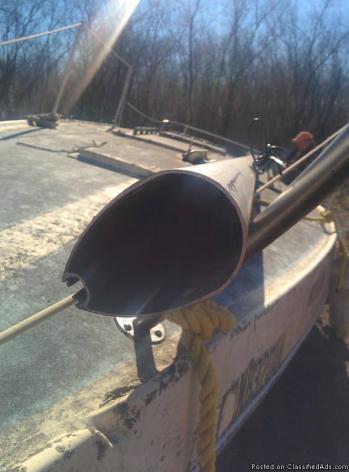
Sailboat Mast
Garnett, Kansas
Posted Over 1 Month
26' aluminum sailboat mast. 4.5" x 3" cross section. Straight and in good condition. No standing rig. Has no wiring or lighting. Includes spreader brackets, cleats and masthead. May be cut shorter for your applicatoon. Mast came off a 1974 26' Clipper Marine I can deliver for 75 CPM round trip FOB Orrick MO. Prepaid. I will use google maps to determine mileage and route.

aluminum Sailboat mast and boom
Boiling Springs, South Carolina
I have an aluminum sailboat mast and boom set I am selling. The boat is long gone and I kept the mast and boom.It measures approximately, 19 ft on mast and 8 ft or 92" on boom If you would like them, call me if interested (941) 228-8631
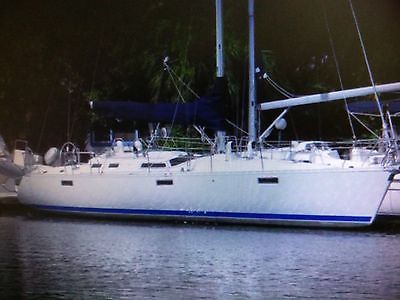
Miami Beach, Florida
Make Beneteau
ngine hours (total): 500 length overall (LOA): 39 make / manufacturer: Beneteau propulsion type: sail year manufactured: 1991 length overall (LOA): 39 make / manufacturer: 1991 Beneteau Oceanis 390 propulsion type: sail year manufactured: 1991 Beneteau oceanis 390 owners version building 1991 powered by Universal diesel very good and clean boatThe BENETEAU Oceanis 390 (39')Owner's Version (Special Layout Design) is the two cabin layout, two head arrangement with separate walk in shower, A large L-Shaped sofa and large folding teak table, galley is to starboard entering from the cockpit, there is also a starboard entrance to the aft cabin, there is a large double berth, a sit down navigation station then aft a head, the main salon is very light and features center line teak table drop-leaf with L-shaped convertible settee at starboard, going forward the head is also starboard with hanging locker to port. The spacious salon is large enough for everyone. Boats for Sale Search YachtWorld United States (change) 1991 Beneteau Oceanis 390 Owners Version Boat Name NOBLE AMBITIONS Specs Builder: Beneteau Dimensions LOA: 39 ft 0 in Beam: 13 ft 5 in LWL: 36 ft 8 in Maximum Draft: 4 ft 6 in Bridge Clearance: 54 ft 5 in Engines Engine 1: Engine Brand: Universal Year Built: 1991 Engine Model: 3m20 Engine/Fuel Type: Diesel Engine Hours: 568 Tanks Fresh Water Tanks: (40 Gallons) Fuel Tanks: (45 Gallons) Holding Tanks: (1 Gallons) Accommodations Number of twin berths: 2 Number of cabins: 2 Number of heads: 2 Layout & Accommodations Salon: Headroom: 6'5 Lockers under berths with rigid water tank (40 gal.) Table with fiddlers, bottle rack Anodized aluminum mast support Deck liner with wooden panels, access to mast wires, sliding shutters Opening deck hatch Opening port in coach house Fixed porthole Bar and shelf along the hull Fluorescent light above table Cushions and backrests with removable covers Grab rail Teak and holly floorboards Forward Cabin: Double bed Lockers on the hull Stowing space under berth Seat with stowing space Shelf, drawer & mirror Hanging locker Two fixed ports Ventilation through dorade Ceiling light Two reading lights Curtains Wooden paneling and vinyl lining Forward head: Formica laminated bulkhead Marine toilet with holding tank Stowage with mirror and door Wash basin with hot and cold pressurized water with shower Opening deck hatch Ventilation through dorade Fluorescent light Accessories: glass with holder, towel holders, toilet paper holder Aft cabin: Double bed Shelf along the hull Hanging locker with mirror Vanity Drawer Settee with stowage Two opening ports on coach roof and cockpit Ceiling lamps Reading lamps Ventilation through dorade Access to back of engine, stern gland, engine water intake and electrical bilge pump Aft marine head with separate stall water Aft head: White Formica laminated bulkhead USCG Marine head with holding tank Washbasin with hot and cold pressurized water Mirror & Shelves Stowing space under washbasin Opening port Fixed port in hull Ceiling light Ventilation through dorade box Accessories: glass with holder, towel holders, toilet paper holder Separate shower Galley The well ventilated functional galley will bring out the cook in everyone. Designed for extended cruising, this vessel offers a large refrigerator/icebox, 3 burner stove with oven and hot &cold pressurized water, stainless steel sinks and stowage space. Hot/Cold pressure water in showers and galley, Immersion Heater & Calorifier , 12v Refrigerator , Cooker/Oven/Grill, Radio (VHF), Cockpit cushions, Showers with self-activated pump-out Electronics & Navigation Chart table with stowing space for charts Shelves under chart table Bookshelf Panel for navigation instruments Electronic panel, 16 functions, hinged for easy access to wiring Fluorescent light Chart reading light Electrical, Power & Plumbing 12v / 120v including shore supply, Hot/Cold pressure water in showers and galley , Immersion Heater & Calorifier , 12v Refrigerator , Cooker/Oven/Grill , Radio CD-Player ,Speakers in saloon and cockpit (with fader), Showers with electric pump-out Deck & Equipment Bow stemhead fitting with anchor roller, fast track attachment, and 2 fairleads with built-in rollers (patented) Self bailing anchor well with mooring eye Mechanical windlass One opening hatch for lighting and ventilation of front cabin and head Pulpit with navigation lights Opening aft push pit with horseshoe buoy support and teak flag pole Anodized aluminum toe rail with 4 fair heads in-corporating built-in rollers (patented), 2 aft and 2 amidships Stainless steel profiled stanchions Double s/s lifelines with opening gates Four dorades with s/s guards Genoa tracks with adjustable car Two teak grabrails Mainsail traveler with adjustable car One winch Lewmar 30 S/T or equivalent for main sheet with cleat One winch Lewmar 30S/T or equivalent for main halyard and reefing lines Two Footblocks Two Lewmar 46 S/T (or equivalent) genoa sheet winches with cleat Four blocks for reefing lines with jammers Two genoa turning blocks Slatted teak seating in cockpit Cockpit table Teak cockpit grating Steering wheel (leather covered) with pedestal compass Two sail lockers with life raft storage in cockpit One gas bottle locks One bathing platform, teak laid, with 2 lockers Rubber protection at base of transom S/s chain plates for shroud, forestay, baby stay and backstay One winch handle holder One double action manual bilge pump One aft self-bailing anchor well One aft anchor roller Swim ladder Companionway step/locker Sent from Yahoo Mail on Android
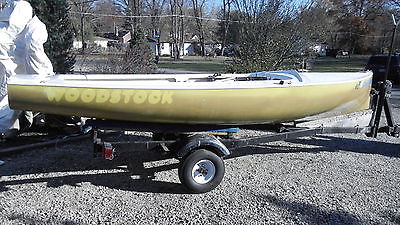
Jet 14 Sailboat race-ready DM-1 mast, includes trailer
Akron, Ohio
Length 14.0
Used jet 14, 1974 hull, new paint, new hardware throughout, DM-1 mast full fiberglass hull, inboard jib tracks. Exterior hull sound, has one small 2" crack in gel coat in bottom near one of the bailers, and several small star dings in the transom on the exterior, looks like its where the mast got shoved into the hull during transport. The interior is in good shape, has two gel coated repairs in the floor at the tanks, but no exterior damage. There is no mainsheet block in the photos, but I will install a Schaefer block. Jas DM-1 mast, aluminum spin pole.
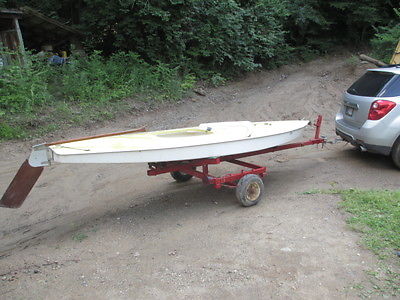
1972 Sunfish sailboat 14' good sail with trailer new wheel tire hitch no mast
West Lafayette, Indiana
Make Alcort Sunfish
Model Alcort Sunfish
Length 14 feet
This is a Sunfish sailboat 14' with trailer. The boat is from 1972. A clear title comes with the trailer. It has a new wheel, tire and hitch with 1 7/8" socket. The sail is in good condition and has the emblem of the black sunfish on it. The two aluminum booms are both there, however the main mast is missing. It has some cosmetic scratches around the seating area, which can be filled in. Pictures of the rudder and the back of the boat show the metal hooks to attach the rudder, which is made of mahogany wood and aluminum. Though I have sailed this boat for many years, but not lately, I forgot how to attach it. The tiller does not have the extension, but it can be easily added. The sail is complete with aluminum booms and pulleys etc. The dagger board is included, as well as an extra paddle. Will Ship Worldwide.
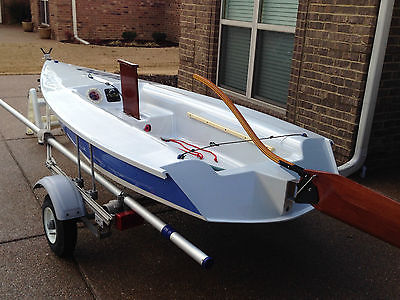
ZUMA Fiberglass Sailboat and Aluminum Trailer, (small sailboat)
Jackson, Tennessee
Make Vanguard
Category Dinghies
Length 12.8
This is a beautiful ZUMA sailboat with a Trailex 250-L aluminum trailer. The boat has large comfortable seating surfaces, a classy looking rudder and centerboard and a really nice reverse transom. This boat looks like a mini yacht being towed down the road. It is a Vanguard built boat, laid up by hand in Portsmouth, RI. It has only been sailed a couple dozen times, and has the original bright gelcoat finish. It has been covered or garaged for most of its life, and it shows. As the pictures taken in the last year or so attest, it looks wonderful. The ZUMA was made by the same folks who build the Laser; but the ZUMA, in my opinion, is much nicer to sail with two people than the Laser. It is a fun boat that is not quite as high in performance as the Laser, but is easier to set up, and requires, perhaps, less athleticism too. It has a zippered luff, so that the sail can be raised and lowered with a halyard; meaning the mast does not have to be lifted in and out every time with the sail already up like a Laser. It takes just minutes to set up, and requires little maintenance. It does move along quite nicely, too. Beginners can sail this boat; or folks like me, with over thirty years of sailing experience, can enjoy it too. The ZUMA is good for almost any age sailor. The boat only weighs 130 pounds and can be towed by most any car out there with a hitch. Be sure, of course, to check your particular car's owner manual. Trailer and all, the towing weight is only around 275 pounds; thanks, in part, to the compact and lightweight alluminum trailer. This boat looks like it is only a year or two old, and it comes with nifty extras. The NORTH sail is in wonderful, almost new, shape. But that's not all. I include a virtually new Neil Pryde sail too. Both sails are very nice looking; and you can change the look of the boat in minutes with just a sail change. It has a Harken tiller extension on a beautiful laminated tiller, and the single bulkhead port has been expanded to two, with storage bags in each port. The lines are all like new and bright in color. The traveler block set is upgraded to the one piece design from the Laser. This package includes a rudder cover and an APS centerboard storage bag. I will also include a HAWK wind indicator, and other little extras (tie-downs, etc.). The SILVA compass was standard on the ZUMA, and is, of course, included. The Trailex 250-L aluminum trailer supports the boat by the gunwales to avoid stress on the bottom. The tires (with galvanized rims) are less than two years old, and I will include a brand new spare with galvanized rim. The spare tire is not mounted on the trailer; but can be stowed in the trunk of a car or back of a truck. The trailer comes with rear LED lights, too! There is also a custom Sunbrella boat cover included. The cover, as might be expected, is the one thing that shows the most signs of wear. It has done its job of protecting the boat, though, and should continue to so so for quite some time to come. New covers should be readily available when this one needs replacing. Pictures tell a good story; but here is some additional information regarding the pictures provided here. The sailing pictures were taken in June of 2014 on the Intracoastal Waterway between Pensacola Beach and Navarre. Most pictures show the boat before the second port was added. Some ZUMA's came with one port, some came with two, for seemingly no rhyme or reason. The boat looks much more balanced with two, and it's handy for extra storage too. Storage bags for the ports are included. I also include two spare port storage bags. Also included is a small oar that can be stored inside the hull. The oar was sized to fit right through the port. An important note: The ZUMA logo on the top of the boat was removed earlier this year. I hated it, and thought the boat looked much more refined without it. I had no intention of selling it when it was removed a few months ago. I kept one of the vinyl letters so that it could be reasonably matched by a sign shop; if you were so inclined to put a logo back on. It looks (IMO) so much nicer now. The boat has some small crazing of the gelcoat here and there (like most any fiberglass boat), and there are a few scratches, but none of that detracts from the overall beauty of the boat. There is normal wear and tear and some rust on the leaf springs of the trailer, but overall it really looks like a year or two old boat and trailer package. You have to see it to appreciate it. The boat is in Tennessee, and if you are within driving distance, it awaits your inspection. I have always taken really good care of my boats. This boat was owned originally by a friend who worked in the sailboat business. He has always taken, perhaps, even better care of his boats than me. It is almost impossible to believe how good this boat looks for its age. Of course, nothing's perfect, but your friends may think it's a new boat. This boat could be a Christmas gift come true for someone wanting to mess about in small boats. New boats of this type start at prices of around 5,000; plus shipping and other costs. The aluminum Trailex trailer alone sells for about 1,100.00. A second ZUMA sail and other extras make this all even more worthwhile. This is truly a good deal. I have copies of the original point of sale literature that will be included with boat purchase; along with the rigging manual for the boat, and assembly manual for the Trailex trailer. I also have the title papers for both boat and trailer. Please email me with any and all questions. Local pickup only, please. You could have it shipped after you buy it; as it would be your boat, but to insure your satisfaction, I would definitely not recommend it. The boat is located about midway between Memphis and Nashville on I-40; with lots of good hotels nearby. I want you to see it, look at the gear, and be completely satisfied before you drive away. This Great Deal Going Off eBay on Thursday! ******** Special note to any would-be buyers living in or near Memphis: This thing would be absolutely perfect for the new, expanded, coming soon, Patriot Lake. What a great place! (well, it will be when they put the water back in next year) ********

Cruising Sailboat
Canastota, New York
Asking $45,000 Call or e-mail to arrange a visit: [email removed] or leave a message on my skype phone at 315-254-2452. The boat is located near Syracuse, NY. For full ad go to: https://persephone37.wordpress.com/ Dreaming of living aboard and sailing off to the islands? Persephone is a beautiful, well-maintained, fully equipped, self-sufficient, center cockpit sloop ready for cruising. As a well equipped and comfortable long-term live aboard yacht, she has taken her current owners to the Caribbean and back to upstate New York a number of times- and now she’s ready to take you to your dream destinations. “Persephone” was designed as the perfect coastal cruising vessel… large enough to be very comfortable yet simple enough to be able to sail her by yourself… a perfect combination of comfort and function. Through years of cruising, thoughtful upgrades and enhancements, her current owners have produced an exceptional live aboard vessel. Her extensive upgrades and refurbishing over the years makes her the one of the best equipped cruisers you will find in this price range on the market. Seasoned sailors will immediately appreciate the new Awl Grip on the hull, and on deck the Lewmar 65 winches and deep comfortable center cockpit protected from the elements by a dodger and bimini. Her windlass makes anchoring simple, and after the anchor is down, a cold beverage from the custom refrigerator will be appreciated. Worried about your beverages warming up at anchor? Never fear- her solar panels and wind generator output provides more than enough power. Down below, she has a spacious salon with center folding dinette, 6' headroom that leads forward to a head and V-Berth. LED cabin lights and aluminum Lewmar port lights keep brighten the interior, day or night. Her two staterooms and two heads offers plenty of room, lots of privacy, and an abundance of storage. When the winds dies, she is equipped with a 32 hp Universal diesel engine, 2 fuel tanks with Racor filters, and two 100 gallon water tanks. Main Salon ***Pictures Below***** The main salon features settees, port and starboard, and a centerline table with folding leaves and storage. There are plenty of opening ports, and an overhead hatch to provide wonderful ventilation. There is a navigator’s station aft of the starboard settee and the galley is aft of the port settee. A large custom made marquetry sailboat scene graces the forward bulkhead to port. Master Stateroom The O’Day 37 has a unique aft cabin master stateroom entered from the cockpit. It is completely private with a wonderful queen size custom pillow-top spring mattress berth. There is a hanging locker to port with storage shelves adjacent to the locker and berth. Additional storage is provided by more shelves and drawers to starboard. Five opening ports, together with the aft cabin companionway, provide wonderful ventilation. A private ensuite head contains a manual head and a vanity sink as well as a single opening port and overhead hatch. Guest Stateroom The guest stateroom is forward in the forepeak and consists of a comfortable v-berth with filler, storage under and in drawers and on shelves. An overhead hatch and an opening port allows for great ventilation. There is a full-size hanging locker aft of this cabin and opposite the head. Galley The spacious well laid out u-shaped galley is to port forward of the companionway and opposite the navigation station. It features 2 deep sinks with a butcher block lid, 3 burner stove with oven, a microwave, and plenty of easy access storage. The large, sensible, easy access refrigerator/freezer has a stainless steel holding plate and is just aft of the navigation table. Cockpit By far, the most comfortable cockpit you’ll find. Deep coamings with just the right angle to sit back and enjoy the sailing or the sunset. The teak table provides room for entertaining and dining all under the shade of the bimini. 2 huge lockers provides storage for everything! The helm has superior visibility while underway. “Persephone” 1981 O’Day Center Cockpit Sloop Builder: O’Day Designer: C. Raymond Hunt Dimensions LOA: 37' LWL: 30’4? Beam: 11’3? Displacement: 14,000 lbs Draft: 5' Bridge Clearance: 47' Ballast: 6,000 lbs Engine: Universal Diesel HP: 32 Tankage Fuel: 50 gals in 2 tanks Water: 185 gals in 2 tanks Holding: 15 gals Rigging & Sails New Rigging – New Stayloks – New Turnbuckles New Fully Battened Mainsail – 8.4 oz. Contender Cloth, 2 reef points Profurl Roller Furling 120 roller furl jib 90/Yankee 9 oz. roller furl jib Barient #10 main halyard winch Barient #18 mainsheet winch Barient #18 jib halyard winch Harken Lazy Jacks Lewmar Boom Vang Oversized Main & Jib Halyards – 9/16 Sampson Yacht Braid All Running Rigging – Samson Yacht Braid 2 Lewmar 65 primary self-tailing winches with Sunbrella covers Schaeffer oversized jib cars Electronics Raymarine 5000 Autopilot with below deck linear drive Standard Horizon DSC VHF Mic WHAM capable New Garmin 740 Touchscreen Color Chartplotter GPS (2012) has US Coastal + Alaska & Hawaii and Bahamas Explorer charts Standard Horizon DS 45 Depth Sounder Standard Horizon Speed Log Standard Horizon Wind Meter JRC 24 mile radar LaCrosse Weather Station Mast VHF Antenna Electrical 12v/110v systems with clearly labeled electrical panel and breakers 12 Volt Ships Power System 30 Amp Shore Power System 3 Siemens 75 watt solar panels on custom built arch 12v lighting Masthead Tri-Color Light/Anchor Light Class 2 Running Lights which are larger & have more visibility range 4 Interstate Deep Cycle Golf Cart Batteries (400 amp hour) New 2008 New Alternator 2009 Aerogen 6 Wind generator 2000 watt Inverter 12 volt bilge pump Propane shutoff solenoid switch for safety in galley Galley U-shaped galley with lots of storage Isotherm stainless steel holding plate DC refrigeration system with bronze March pump and digital Carel Controls Hot/cold pressure water Shurflo freshwater pump Hillerange LPG 3 Burner Stove with oven Microwave Oven 2 deep stainless steel sinks Cabinets, drawers and top loading dry storage locker Butcher block sink cover for added counter space Force 10 stainless steel 6 gallon hot water heater engine exchange Accomodations New LED lighting in main cabin 15” Flatscreen television with DVD player AM/FM stereo with 2 speakers Teak Interior with Teak & Holly Sole Large Framed Marquetry in Salon Sckandvik Faucet/Shower – Forward Head New Jabsco Toilets (2009) (3) opening hatches, (16) opening Lewmar aluminum ports Screens for some ports Engine 3 Engine room lights Rebuilt Universal diesel fresh water cool engine with easy access from front and back with 2 New water pumps and heat exchanger PSS Dripless Shaft Seal Hurth Transmission new 2004 Groco Bronze Sea strainer Dual Fuel Tank System with Dual Racor Filters – 50 gallon capacity AWAB 316 Stainless Steel hose clamps used throughout – Superior Non-Perforated – Lasts forever Deck New vinyl covered stainless steel double lifelines with opening gates each side Foam vinyl covered custom cockpit cushions Dodger with attached Bimini Anchor Locker Propane Locker on Aft Deck 44 lb Bruce Anchor with new (2012) 110’ oversized 3/8” chain and 120' 5/8” rope rode Fortress FX 23 with 50’ 3/8” chain & 80’ 5/8” rope rode Lewmar 2000 Electric Windlass Polished Stainless Steel Engine Controls 28” Stainless Steel steering wheel Stainless Steel Ritchie Compass at Helm Stainless Steel Bow Pulpit Stainless steel Stern Rail with opening gate Stainless steel built-in stern swim ladder Brushed stainless steel custom-built stern arch with dinghy davits Manual bilge pump Keel stepped mast Performance fin keel Stainless steel bow chocks 3 Bow Cleats Mainsail Cover Custom made companionway washboards with Lexan windows Edson Pedestal with Pedestal Guard Teak folding cockpit table with 4 cup holder Outboard Motor storage board Lifesling with Sunbrella cover Force 10 BBQ propane grill with custom cover Additional Davis radar reflector USCG safety equipment Boat hook, lines, fenders Emergency Tiller
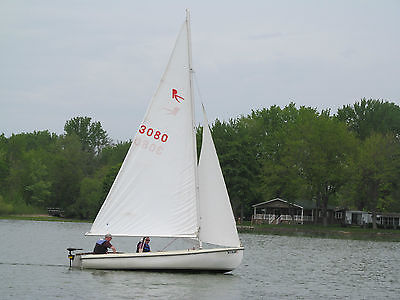
Rebel 16 Mark II Sailboat with Aluminum Trailer
Angola, Indiana
Category Daysailer Sailboats
Length 16.6'
Stable fiberglass sailing boat carries six people (or 1170 pounds). Includes trailer, full rigging, and TWO suits of sails. One suit of sails is in like new condition, the other set is in very good condition. Serial number 1929 (built in late sixties to early seventies I believe). The centerboard swings up into the cockpit, so you can change the depth to dock in shallow water. The rudder also swivels up if it hits an obstruction. The trolling motor in the photos is not included. There is, however a permanent motor mount on the stern. The boat will take up to a 5hp motor, but my 30lb. thrust trolling motor drives it around just fine. The boat is located on West Otter Lake, Angola, IN. Buyer with the selling price in cash or Pay Pal payment can drive it away. (Trailer takes an 1 7/8" ball hitch.) The following article from Sailing Magazine gives a great description of Rebel sailboats. You can access the original on SailingMagazine.net. Rebel 16 2008 January 8 By Staff This nimble and tough classic is perfect for a daysail or a day of racing This year the boat that holds claim to being America's first production fiberglass one-design will celebrate its 60th birthday. That the boat is still in production makes this milestone that much more remarkable. In 1948, fresh out of the Navy, Ray Greene began building a 16-foot family daysailer out of his Toledo, Ohio, shop using a revolutionary new material called fiberglass. The design of the boat was based on lines drawn by a local high school drawing instructor by the name of Alvin Younquist. With its wide, 6-foot, 7-inch beam and 110-pound steel centerboard the stable little boat known as the Rebel soon became a hit on the Midwest's inland lakes. And while Greene said he never intended to create a racer, thanks to the boat's performance-courtesy of a large 120-square-foot main and 46-square-foot jib on a fractional rig-it wasn't long before a competitive structure was built around the boat. By 1952 a class association had been firmly established and by 1963 the class boasted 138 active members. Not bad. Fleets started popping up across the Midwest, south into Kentucky and all the way down to Texas. Meanwhile, class members could be found sailing the inland lakes of the Eastern Seaboard from New York to Florida. After 25 years of building the Rebel, with more than 3,000 hulls produced, Greene was ready to call it quits and sold the works to a group of Chicago investors. Production of the Rebel continued at a steady pace during the 1970s, and was done under a number of names: Melling Tool Co., Rebel Industries and finally Spindrift One Designs. After Spindrift folded, the Rebel moved to Michigan in 1988 when Nickels Boat Works of Fenton took over with the production of the Mark V model. Nickels continues to build the Rebel, offering buyers a choice of a daysailer version for $9,860 or the optimum racing version for $11,872 less sails and trailer. A stainless steel centerboard now comes standard with the Rebel. Nickels also continues to be a great source for parts and accessories, as well as information, on the Rebel. One tough Rebel While there have been reports of problems with the foam flotation on older boats becoming waterlogged, that has been less of a problem on boats from the 1970s and later. Other than that, a buyer of a used Rebel should find few issues with the condition of this durable little boat. Indeed, boats 25 years and older will still top regatta leaderboards. "They're well made, very rugged boats that will last forever," said Al Vorel, National Rebel Association Commodore, who has been racing the same boat, No. 3914, for almost 20 years. "You don't have to run out every 5 to 10 years to buy a new boat." This is one of the reasons for the longevity of the class. Boats tend to stay in the family, passed down from parent to child, with the younger generations wanting to keep the racing going. "My mother races, and my daughter sometimes races, so there are times we'll have three generations on the course," Vorel said. This also, of course, keeps a lot of boats off the market, and finding a used Rebel can be a bit of a challenge. But thanks to the Internet, it's possible to locate a few sellers. Prices can vary from just under $1,000 for an older boat in need of some work to $3,000 or more for a later model. Buyers can typically expect to pay in the neighborhood of $1,500 for a pre-Nickels-era boat in good shape. We were fortunate enough to find a late 1970s Rebel listed for sale on www.craigslist.org. Better yet, the seller was within trailering distance. The offer on the boat was $1,400, so we drove out to take a look. The boat was well cared for, kept under a roof winters, and showed no structural damage. Other than some algae stains and scuff marks the finish looked good, and all the gear was there, including the main and jib, which the owner said he bought new about seven years ago. We did see some possible issues, including a rusty, pitted centerboard and a wooden rudder that looked to have some rotting. So we offered to pay the full $1,400 if the owner threw in the trailer, which he originally wanted an extra $200 for. The deal was closed and we drove off with the Rebel in tow. Rebel with a cause With the boat parked in our yard the first item of business we wanted to take care of was the rusty centerboard. Nickels offers a stainless steel replacement board, and we could picture how sweet the boat would look with a shiny new stainless fin. Unfortunately, these centerboards run close to $1,000; more than two-thirds the cost of the entire boat. So such an extravagant purchase didn't make much sense. Instead we set about rehabilitating the old board. We removed, with a bit of difficulty, the 110-pound board and set in on sawhorses. The first step was to remove the old paint using paint stripper, then power sanding. We then slathered on some Duro Naval Jelly to remove the rust, wiping down everything with paper towels then finishing up with a clean, acetone-soaked rag. Next, we filled in the pits and hollows with West Marine Surfacing Putty, and sanded everything smooth. We made certain the blade was fair by running a straight edge along the board. We also further faired the rounded leading edge of the board to within the class rule limits, which prohibit tapering less than 1/16th of an inch and more than one inch in from the leading edge. We then primed the board with several coats of Interlux Primocon primer, which when dried we wet sanded with 400-grit paper, and finished with a couple coats of Interlux VC-17m Extra bottom paint. With the centerboard done, we then turned to the rudder. An ice pick determined the wood was beginning to rot near the lower trailing edge. We probably could have rehabilitated the rudder as well, but since we had saved some money by not replacing the centerboard we decided to spring for a new rudder. We opted for a fiberglass blade, supplied by Nickels for $375. This cost covered just the blade, as the original aluminum rudder cheeks and hardware were still in good shape. While we were on the phone with Nickels, we decided to order all new running rigging to replace the weathered lines the boat came with. This included lines for the cunningham, boom vang, centerboard system, as well as sheets and halyards for both main and jib. The total for 112 feet of ¼-inch line and 105 feet of 5/16-inch line came to $100. Next we took a closer look at the standing rigging. The spars showed no defects, and with a bit of metal polish and elbow grease the rotating mast, boom and aluminum whisker pole looked good as new. The 1-by-9 stainless steel shrouds and forestay also showed no visible defects. We did, however, find the diamond stays on the mast to be tuned rather tight. According to the North Sail's One-Design tuning guide for the Rebel, an overly tight diamond can limit fore and aft mast bend, and can even cause negative pre-bend, where the mast bends forward at the tip. Since we want to have a competitive boat, we loosened the diamond tension and will readjust after doing some sea trials. As we said, we ultimately wanted to race our Rebel and didn't want a slow boat. So obviously the 7-year-old suit of sails had to go. This would be our biggest expense, and a new suit of sails would alone exceed the original cost of the boat. A new main and standard jib (a light air jib is also available) from North Sails set us back $1,615, which included $20 for class royalties but not shipping. Certainly this was a blow to our budget, but we rationalized it by thinking about the fun we would be having with some close racing come summer. Our last order of business was getting our bottom clean and smooth. We first scrubbed the hull down with a detergent then wet sanded everything below the rails to a slick surface with 1,200-grit paper. After a rinse and wipe down with the hose and clean towels we were satisfied we had a slick bottom. We finished off by treating all our hardware and moving bits to a little McLube Sailkote spray. We now have what we feel will be a contender on the course for our racing crew of two. Yet, with the roomy Rebel cockpit that can seat six, we're also looking forward to some lazy summer daysailing when friends and family show up. Either way, we'll certainly get our money's worth from this tough but nimble little classic. LOA 16' 1.5" LWL 15' 10" Beam 6' 7.5" Draft 3' 4" Weight 700 lbs, Sail area 166 sq. ft.

32' CATAMARAN SAILBOAT HULL / LARGE PROJECT SAILBOAT
Dayton, Ohio
Relisting do to non-paying low feedback Buyer..... Up for sale is a 32' Catamaran sailboat hull in need of a total rebuild. This open water sailboat is in poor condition but the hull is ridged and strong. I purchased this sailboat from a marina in Waukegan IL in 2008. The marina did provide me with a clear title. The hull is thick fiberglass and we considered it a good candidate for a full rebuild. The hull is the only thing we considered usable on the entire boat. Lower hull is all glass and very ridged. One thing that will need to be fixed, there is a steel skid runner that extends the entire length of the bottom of the hull, (it is a piece of like 1.5" x 1.5" angle iron that they bonded to the bottom of the hull). This runner should have been out of stainless or aluminum but it was done in steel and it is rusting. A line of fiberglass around it has split. You will want to simply cut out all of this steel skid runner and either replace it or simply remove it as it is not needed. There was an inboard engine and drive but I parted that out some time ago as it was not going to be part of the rebuild I had planned. There is also a large aluminum mast with roller furler included but the mast was damaged while in storage, (yard maintenance guy drove over it about 4' from the top). This catamaran hull will need a total rebuild and is sold AS/IS. Do not buy this boat if you are thinking you can just paint it and throw some sails on it. Transport is of course the issue. There is no trailer. Beam is a little over 14', (we permitted at 14' for transport). I personally, would think about sectioning the boat right down the center for transport. I have done this before to a 45' boat that we were reconfiguring. It can be done in a day with a common circular saw. It can then easily be pulled with a gooseneck trailer and a p/u truck. Another possible transport strategy would be to find a carrier who can haul the boat on a 45degee angle on a low deck trailer. We can crane load from our location on to your transport or you can possibly just back the trailer under the elevated twin hulls. Loading and transport is obviously at buyers expense. I am sorry, I simply do not have the time to get involved with transport estimates and logistics. Good luck bidding and please, no zero feedback or low feedback buyers unless you contact me first. ****The Ohio River is less than 50 miles away from our location. There have been Ebayer's suggestions that possibly some basic hull repair is done on location and then the cat is towed down the Ohio River. This is a possible transport solution.

Sanibel 18 Sailboat
Inglewood, California
Make International Marine
Model Sanibel 18
Category Cruiser Motorcycles
Length 18 Feet
Wonderful Pocket Cruising Sailboat Easy to Launch beach-able Sleeps 4 spacious cockpit Premium Blue Water Lay-up Cloud White Hull and Deck Composite High Performance Kick-up Beaching Rudder Porta-Potti Screened Opening Ports (2 pair) Screened Forward Hatch Fabric Covered Cabin Cushions Stainless Steel Bow Pulpit Stainless Steel Transom Boarding Ladder Stainless Steel Cleats and Chocks Aluminum Backing Plate for Engine Adjustable Motor Mount Mast Raising System (allows a single person to step and raise the mast) Trailer – Included Galvanized Baja Trailer Trailer Tongue Jack with Wheel Trailer Guides and Mast Crutch Sails and Handling Equipment – Included 6 Oz White Mainsail with One Set of Reef Points 6 Oz White 110 % Lapper Jib On Boom Jiffy Reefing System Boom Vang Mast Topping Lift Backstay 12 Volt Electrical System – Included Bow and Stern Running Lights with Panel Cabin Interior Dome Light Masthead Combo Anchor/Steaming Light Marine Battery Box Optional Items can be offered factory installed
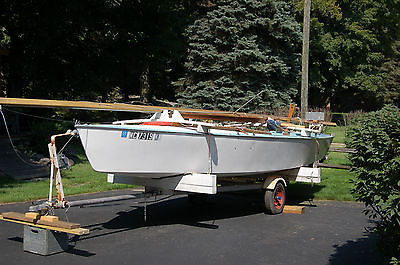
Sound Winter Project Sailboat
Rapid City, Michigan
Make Lightening
Length 19.0
19 Ft. Fiberglass Sailboat with wood interior. Aluminum mast w/ wood boom. Includes all sails, main, jib and spinnaker and wood rudder/tiller. Fiberglass is sound, the wood needs to be refinished. Floorboards have been 'stripped' and are ready to be stained and varnished. Includes trailer. Slight work and you have a classic sailboat for years to come. $1,350

Andrews 30 Racing Sailboat
Carlyle, Illinois
Make Andrews 30
Category Racer Boats
Length 30.0
FLAGS 1987 Andrews 30 Racing Sailboat. Never sailed in salt water.Harkin Cars and Blocks, Hydraulic Back Stay Adjuster, and Vang control runs back to Main Trimmer. Harkin Forestay track system. Aluminum and Carbon Spinnaker Poles. Harkin Mainsheet system with coarse and fine tune. Mast Module,NKE Instruments Sail Comp,2 Dual Maxi Displays and True Wind display. GPS on rotating arm. Feathering Propeller with view port in hull. Nav station.Volvo 2 Cylinder engine. Set up for Crane Lift and Launch.Custom Trailer. Flags has had a very successful racing history in Lake Michigan 2008- LMSRF Boat of the Year -1st PHRF , Verve Cup Regatta - 1st Div.7, NOODS -1st PHRF Div.4, Chicago-Waukegan Race -1st PHRF Section 4, and UK Halsey Regatta - 2nd PHRF Sec.2. And many more.
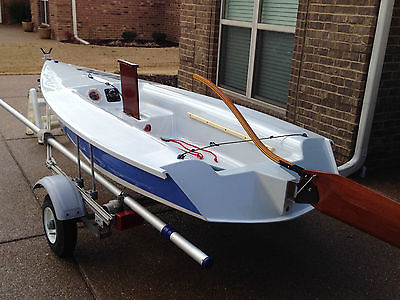
ZUMA Sailboat and Trailer
This is a beautiful ZUMA sailboat with a Trailex aluminum trailer. It is a Vanguard built boat that has only been sailed a few dozen times. It has been covered or garaged for most of its life, and it shows. As the pictures taken in the last year or so attest, it looks wonderful. The ZUMA was made by the same folks who build the Laser; but the ZUMA, in my opinion, is much nicer to sail with two people than the Laser. It is a fun boat that is not as high in performance as the Laser, but is easier to set up, and requires, perhaps, less athleticism too. It does move along quite nicely. Beginners can sail this boat; or folks like me, with over thirty years of sailing experience, can enjoy it too. The ZUMA is good for any age sailor that has been properly taught. It takes just minutes to set up, and requires little maintenance. It has a zippered luff, so that the sail can be raised and lowered with a halyard; meaning the mast does not have to be lifted in and out every time like a Laser. The boat only weighs 130 pounds and can be towed by most any car out there with a hitch (check your manual, though). Trailer and all, the towing weight is only around 275 pounds; thanks to the lightweight trailer. This boat looks like it is only a year or so old, and comes with nifty extras. The NORTH sail is in wonderful, almost new, shape. But that's not all. I include a virtually new Neil Pryde sail too. Both sails are very nice looking. It has a Harken tiller extension on a beautiful laminated tiller, and the single bulkhead port has been expanded to two, with storage bags in each. The lines are all like new and bright in color. The traveler block set is upgraded to the one piece design from the Laser. This package includes a new rudder cover and a new centerboard storage bag. I include a HAWK wind indicator and other little extras. The SILVA compass was standard on the ZUMA, and is, of course, included. The Trailex aluminum trailer supports the boat by the gunwales to avoid stress on the bottom. The tires (with galvanized rims) are less than two years old, and I will include a brand new spare with galvanized rim. Spare tire is not mounted on trailer; but can be stowed in trunk of car or such. The trailer comes with LED lights, too. There is also a custom Sunbrella boat cover included. The cover, as would be expected, is the one thing that shows the most signs of wear. It has done its job of protecting the boat, though, and should continue to so so for quite some time to come. New covers should be readily available when this one needs replacing. Pictures tell a good story; but here is some additional information regarding those pictures. The sailing pictures were taken in 2014 on the Intracoastal Waterway near Pensacola Beach. Most pictures show the boat before the second port was added. Some ZUMA's had either one or two, for seemingly no rhyme or reason. The boat looks much more balanced with two, and it's handy for extra storage too. Storage bags for the ports are included; along with a small oar that can be stored inside the hull. The oar was sized to fit right through the port. The ZUMA logo on the top of the boat was removed earlier this year. I hated it, and thought the boat looked much more refined without it. I had no intention of selling it when it was removed, but you could always have a sign shop do a logo to pretty much match it, if you were so inclined. The boat has some crazing of the gelcoat here and there, and there are a few scratches, but none of that detracts from the overall beauty of the boat. There is normal wear and tear on the trailer, but once again, it looks like a year or two old package. You have to see it to appreciate it. The boat is in Tennessee and if you are within driving distance, it awaits your inspection. I have sailed for over thirty years and take really good care of my boats. This boat was owned originally by a friend who takes, perhaps, even better care of his boats. It is almost impossible to believe how good this boat looks for its age. Nothing's perfect, but this boat could be a Christmas gift come true for someone wanting to mess about in small boats. New boats of this type start at prices of 5,000 and up; and the Trailex trailer alone sells for about 1,100.00. A spare sail and extras make this all even more worthwhile. I have title papers for both boat and trailer. Please email me with any and all questions. There is video of this boat being sailed also available; if you want to see it in action. The entire package is ready to be towed away by the buyer. I want you to see it, look at the gear, and be completely satisfied before you drive away. You will be pleased.
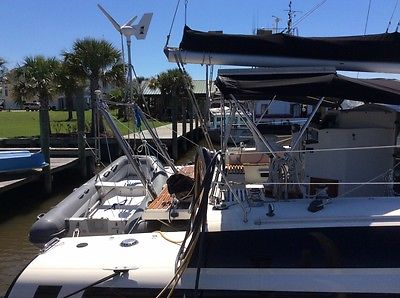
Crusing Catamaran Sailboat
Slidell, Louisiana
Make Fountaine Pajot
Length 38.5
Cha Ching is a very well maintained and upgraded cruising catamaran. She sails fast and points to wind better than most catamarans. The large centrally located helm station allows for visibility at all four corners of the vessel, and features two entrances to the salon. The galley up configuration and ample 6 seat dining table makes entertaining fun for everyone. This fine vessel is offered at $165,000, which is significantly less than the last appraised value (appraisal available upon request). Owner has purchased a new catamaran and is motivated to sell. Bring all offers! Reliable low cost delivery of vessel by licensed captain available. DIMENSIONS: LOA- 38.5 ft. BEAM- 21 ft. DRAFT- 4’2 MAST HEIGHT- 58.5 ft. MANUFACTURER: Fountaine Pajot 1990, Model- Fiji NUMBER OF CABINS: 4 (2 Heads with showers) TANKAGE: Fuel- 55 gallons upgraded stainless tanks, Water- 120 gallons main tank, 45 gallons reserve (aluminum). Two holding tanks with macerator pumps (one each hull). ENGINES: 2 Inboard Diesel- Volvo Penta, Model- 2002 Approximately 1500 hours each TENDER: 12 foot AB hard bottom inflatable with 15 HP Evinrude (2 stroke) ELECTRONICS: All new Garmin Electronics in 2014 including Garmin 546-S Chart Plotter with blue chart chips, GMI-10 (one at nav station and 3 at helm), GHC 10 autopilot with GHC10 wireless remote, Standard Horizon VHF with DSC connected to GPS at nav station, with Ram 3 microphone at helm, ICOM M802 Single Sideband Radio, JRC 1500 MK II Radar, West Marine Submersible hand held VHF radio, Pioneer DH 2200 UB with Ipod and Iphone connectivity. MECHANICAL/ELECTRICAL: Pressurized hot and cold water to heads and galley. Hot water produced from heat exchanger on Stbd. Engine. Hot and cold shower on transom at cockpit. Fully air conditioned with Cruiseair STX-16 (16,000 BTU reverse cycle unit new in 2012) and one 6000 BTU unit in each hull. House Batteries- 8- 6 volt golf cart batteries new in 2015, and one starting battery 12v new in 2015. All LED nav lights installed 2014. Halogen salon lights replaced with LED lights, courtesy rope lights for “mood lighting”. 2 automatic and manual electric bilge pumps, one manual bilge pump in cockpit. 6 solar panels mounted on bimini with charge controller, Kiss wind generator on davits. Set up for water maker under Stb. forward berth with electrical and plumbing connections installed. New Barber Adler refrigerator (new compressor installed 2015) and Engle refrigerator/freezer in Port forward cabin. New 2000 watt charger inverter installed in 2014 with AC outlets in each cabin, head, galley, and nav station. ENO brand Propane 3 burner stove and propane grill at transom. Yamaha 3200 EFI gas generator powers AC system. DECK AND SAILING EQUIPMENT: Fractional rig aluminum Z-Spar mast and boom, with 3 Lewmar winches at mast base. Mainsail new in 2010 (heavy cruising main with 3 reefing positions). Boom vang installed 2010. Genoa on roller reefing with UV protective canvass and padeyes for downwind sailing. 2 large Lewmar 45 winches at cockpit and 2 smaller Lewmar winches for traveler. 65 lb. CQR anchor on crossbeam roller with 200 foot 5/8” chain rhode. Goiot electric windlass. Large plow anchor with 100’ chain and rope rhode, and one mud anchor. 6 aluminum mooring cleats. Crossbeam reinforced and compression post added in 2012. Dinghy on stainless davits with stainless steel chain, anchor, etc. Fully enclosed cockpit with custom canvass enclosure that allows for operation of vessel while deployed (with spare set of new forward dodger windows) ADDITONAL NOTES: This vessel has sailed all over the Caribbean and proven herself more than capable for longer offshore bluewater cruising. The boat is equipped with spares like fresh water pump, engine parts (alternator and starter motor, impellers, gaskets, relays, etc.). Other amenities like custom made sunscreen that fits over the entire bow and salon of vessel is included. The vessel recently had all bottom paint removed by soda blasting and new epoxy barrier coat installed along with new Trinidad SR bottom paint (high copper content). The large roomy cockpit comes equipped with 2 large storage lockers, and newly varnished teak benches and drain boards. Aft of the cockpit is a 2 foot varnished teak dinghy dock with plenty of room for generator, large cooler and space for shower and rinsing snorkel equipment. All bilges were sanded and repainted in 2014. New holding tanks and macerator pumps installed 2015. The boat comes with a newly certified 6 person valise life raft which was purchased in 2012. You must see this vessel in person to fully appreciate the level of maintenance and upgrades that have been done to this boat. She is truly ready to sail away.

1980 Pearson 35 Sailboat
Oyster Bay, New York
Classic 1980 Person 35 w centerboard shoal draft and equipped w Fairclaugh custom canvas cover and 400 lb mooring. On the hard in Oyster Bay, New York - ready for viewing. Well maintained vessel. Masthead sloop w deck stepped mast and aluminum spreader. Equipped w Harken roller furling on jib (new 2004), Main sail (very good condition), Genoa 110 and 135. All sails are in good to very good condition. Lots of storage, great u-shaped aft galley, large sink, expansive counter space makes for ease in entertaining. Mast, standing rigging were replaced in 2003/2004. Summer of 2010 new motor mounts, alternator, water pump, water separator, fuel pump and added 2nd fuel filter. 2014 new bilger pump and fresh water pump, 2010 new heat exchanger, muffler system and 6 gallon hot water tank as well and black water holding tank, head and pipiong. 2007/2008 replaced Spectra line and rollers for raising centerboard. Vessel equipped w Garman GPS Model 500 (purchased 2011), VHF radio, depth sounder and speed indicator, hot/cold pressurized water, shower, new (2004) Lerwmar external mount anchor windlass, fresh water wash down in anchor locker, private bathoroom has head, shower and sink. Must see. Well maintained vessel. Make an offer. Owner negotiable. Photos: www.sellyourboatnow.shutterfly.com Contact: Steve/Patty (631)896-6212
Narrow Results
Current search reset all.
- Keyword: aluminum sailboat mast
- Macgregor (3)
- Bavaria (2)
- International Marine (2)
- MacGregor (2)
- Vanguard (2)
- Alcort Sunfish (1)
- Andre Cornu (1)
- Andrews 30 (1)
- BENETEAU (1)
- Barnett Boat Company (1)
- Beneteau (1)
- C&C Yachts (1)
- Cape Dory 27 (1)
- Catalina (1)
- Chrysler (1)
- Fountaine Pajot (1)
- Gulfstar (1)
- Gulfstream (1)
- HALLBERG RASSY (1)
- Heritage West Indie (1)
- Island Packet (1)
- Island Trader (1)
- J Boats (1)
- Jack A Helms Co. (1)
- Jeanneau (1)
- Lightening (1)
- Lippincott Boat Works (1)
- Newport (1)
- Pearson (1)
- Skip Ethells (1)
- Skookum Marine (1)
- Sol Cat (1)
- Southernsail Skiffie (1)
- Tayana 37 (1)
- Universal Marine (1)
- Unlimited (1)
- West Wight Potter (1)
- Cruiser Motorcycles (15)
- Sailboats (7)
- Daysailer Sailboats (6)
- Racer Boats (4)
- Sloop Sailboats (4)
- Dinghies (2)
- Motorsailer (1)
- Florida (15)
- California (10)
- Michigan (8)
- New York (8)
- Connecticut (5)
- Maryland (4)
- Massachusetts (4)
- Indiana (3)
- Rhode Island (3)
- Wisconsin (3)
- Colorado (2)
- Illinois (2)
- Pennsylvania (2)
- South Carolina (2)
- Tennessee (2)
- Virginia (2)
- Washington (2)
- Alabama (1)
- Georgia (1)
- Louisiana (1)
- Mississippi (1)
- North Carolina (1)
- Ontario (1)
- US Virgin Islands (1)
- POP Yachts (5)
- Search Title Only
- Has Picture
- Include Sold Listings
Showcase Ads

2011 Duckwater 18 ocean
Elbridge, NY

2008 Century 2600
Cincinnati, OH

2008 Sea Ray 260 Sundancer
Lake Oswego, OR

2004 Hydra-Sports 230 WA
La Marque, TX

2016 Regal 2000 ES
Columbia, MO

2017 Parker 21 Special Edition
Everettville, WV

2022 Sylvan L3CLZDH
Antioch, IL
Create Alert
Please, name this search
Select Interval
Alert Successfully Created

VIDEO
COMMENTS
Mast Height from DWL: 45.92 ft / 14.00 m: Sailboat Links. Designers: ... Numbers below 20 indicate a lightweight racing boat, small dinghy and such; 20 to 30 indicates a coastal cruiser; 30 to 40 indicates a moderate bluewater cruising boat; 40 to 50 indicates a heavy bluewater boat;
We have built masts from 30 to 140 feet (10 to over 40 meters) in length. fittings and rigging. ... The mast we built for the 68' Ketch featured below was so much lighter than the aluminum mast it replaced, the boat actually floated noticeably higher, and the stainless bow sprit support that always sat just below waterline was now above. ...
Replacing a mast costs between $15,000 - $30,000 for an average sailboat. Out of that, $4,000 - $6,000 is the cost of labor. The mast itself costs between $10,000 - $25,000. The total cost of a sailboat mast replacement raises exponentially as you go up in boat size. But since there are many variables in this, let's have a look at it in more ...
The changes in this version allowed it to rate as an IOR 3/4 ton (24.5). (Including taller mast and shorter boom.) Also called NEWPORT 30 PHASE II. Shoal draft version: 3.75'/ 1.14m.
Westerly Seahawk 35; Westerly Kestrel 35; Westsail 32; Willard 30/8t; X-332; X-342; Medium sized cruising yachts like these are capable of serious offshore passage making, whilst being reasonably economic to maintain and operate. And for competitive types, 30-35 foot cruising yachts are a popular size for club racing under handicap rating rules.
A boat that exemplifies the fast, comfortable and solidly built 30-footer of the 1970s. The early 1970s was the heyday of the 30′ racer/cruiser. The phenomenon was not a coincidence. The Midget Ocean Racing Class (MORC) with a maximum boat length of 30′ had become highly popular. The IOR Three-Quarter Ton Class (a "poor man's One Ton ...
The Pearson 30 has a well-proportioned masthead rig. The mainsail comprises 44% of the working sail area, more than is found on many modern "racercruisers," but a reasonable proportion for a true multi-purpose boat. Base price in 1971 was $11,750. By November 1979, base price had jumped to $28,300.
Here's How Tall Sailboat Masts Are: As a general rule of thumb, the height of a boat's mast will be somewhere between 1.25 to 1.35 times the boat's length, for an average of about 1.3 times the length overall (LOA) of the boat. An aspect of 2.5 or lower will be a low-aspect rig; above that is considered a high-aspect ratio.
Catalina 30 is a 29′ 11″ / 9.1 m monohull sailboat designed by Frank V. Butler and built by Catalina Yachts between 1976 and 2008. ... Sail area in square feet, ... (the lateral area above the deck between the mast and the forestay). D: Displacement in pounds. 15.17 <16: under powered. 16-20: good performance >20: high performance. Ballast ...
It takes into consideration "reported" sail area, displacement and length at waterline. The higher the number the faster speed prediction for the boat. A cat with a number 0.6 is likely to sail 6kts in 10kts wind, a cat with a number of 0.7 is likely to sail at 7kts in 10kts wind. KSP = (Lwl*SA÷D)^0.5*0.5
The Catalina 30 MkII is a 29'11" (9.12m) cruising sailboat designed by Frank Butler (United States). She was built between 1986 and 1991 by Catalina Yachts (United States). The Tall rig version displays a taller mast and larger sail area. The Catalina 30 MkII is as well listed, on Boat-Specs.com, in Fin keel and Wing keel version (see all the versions compared).
On the water, the Morgan 30 is a fine boat to look at, with springy sheer and an attractive stern. Although the boat has a full 6-foot, 2-inch headroom, the freeboard is low. ... Wheel steering brings all the sail control lines closer at hand. The mast is a slightly tapered, deck-stepped, single spreader rig. ...
An evolution of the JOKER S30 (1968). (IOR 1/2 ton) After Albin Marine went out of business in 1982, the molds were acquired by the Ballad One-Design Association and leased to a number of different yards in Sweden that built a few more boats until 1998. "Reported" sail area is based on Main + 135% Genoa.
The boat quickly develops weather helm as it heels, a not uncommon trait of wide boats such as the Catalina 30. Even sailing upright on a broad reach, there is a fair amount of weather helm. This is minimized with the tall rig/bowsprit option, and can be reduced on the standard rig by raking the mast forward slightly, and having the mainsail ...
Save Weight Aloft. A Forte carbon fiber mast weighs about half that of an aluminum mast. Weight savings aloft translates into increased righting moment and reduced pitching moment. In heavier winds, your boat will pitch less in chop. Increased righting moment means you can keep more sail up and/or sail with less crew under any heavier conditions.
Dec 2, 1999. 15,184. Hunter Vision-36 Rio Vista, CA. Apr 20, 2010. #2. I do not think you can handle the mast on a 40' sailboat without a crane. This mast must weight several hundred pounds. Most of the trailer sailors can have problems with their short sticks on a 26' boat. The cost of replacement is not worth the risk.
30' Catalina 30, 1977 For Sale in Elephant Butte, New Mexico Catalina has been one of the most popular sailboat builders in America. Designed by legendary boat builder Frank Butler, the Catalina 30 has been one of the most popular and longest production cruisers of any boat in her class. Her beamy 10' 10" hull provides for a spacious cabin that ...
Mast Height from DWL: 42.25 ft / 12.88 m: ... with more than 1000 built, this was one of Pearson's most successful models. The designer, Bill Shaw, owned a Pearson 30 for a number of years. Early models had Palmer inboards. ... Calculations Help. SA/Disp.: A sail area/displacement ratio below 16 would be considered under powered; 16 to 20 would ...
26' aluminum sailboat mast. 4.5" x 3" cross section. Straight and in good condition. No standing rig. ... s guards Genoa tracks with adjustable car Two teak grabrails Mainsail traveler with adjustable car One winch Lewmar 30 S/T or equivalent for main sheet with cleat One winch Lewmar 30S/T or equivalent for main halyard and reefing lines Two ...
It takes into consideration "reported" sail area, displacement and length at waterline. The higher the number the faster speed prediction for the boat. A cat with a number 0.6 is likely to sail 6kts in 10kts wind, a cat with a number of 0.7 is likely to sail at 7kts in 10kts wind. KSP = (Lwl*SA÷D)^0.5*0.5
Mast Height from DWL: 50.00 ft / 15.24 m: Sailboat Links. Builders: Hunter Marine (USA) Related Sailboats: HUNTER 30-2 ... Numbers below 20 indicate a lightweight racing boat, small dinghy and such; 20 to 30 indicates a coastal cruiser; 30 to 40 indicates a moderate bluewater cruising boat;
Mast Height from DWL: 44.00 ft / 13.41 m: Sailboat Links. Designers: ... Numbers below 20 indicate a lightweight racing boat, small dinghy and such; 20 to 30 indicates a coastal cruiser; 30 to 40 indicates a moderate bluewater cruising boat; 40 to 50 indicates a heavy bluewater boat;
The standard rig includes a fin keel with skeg hung rudder with draft as shown here. The tall rig has an extra 3 feet of mast, 5.5' of draft and an extra 500 pounds of lead. (Sometimes referred to as TARTAN 30C.) The interiors came in a center galley and aft galley version. Standard power was the Atomic 4 while some came with a Faryman Diesel.